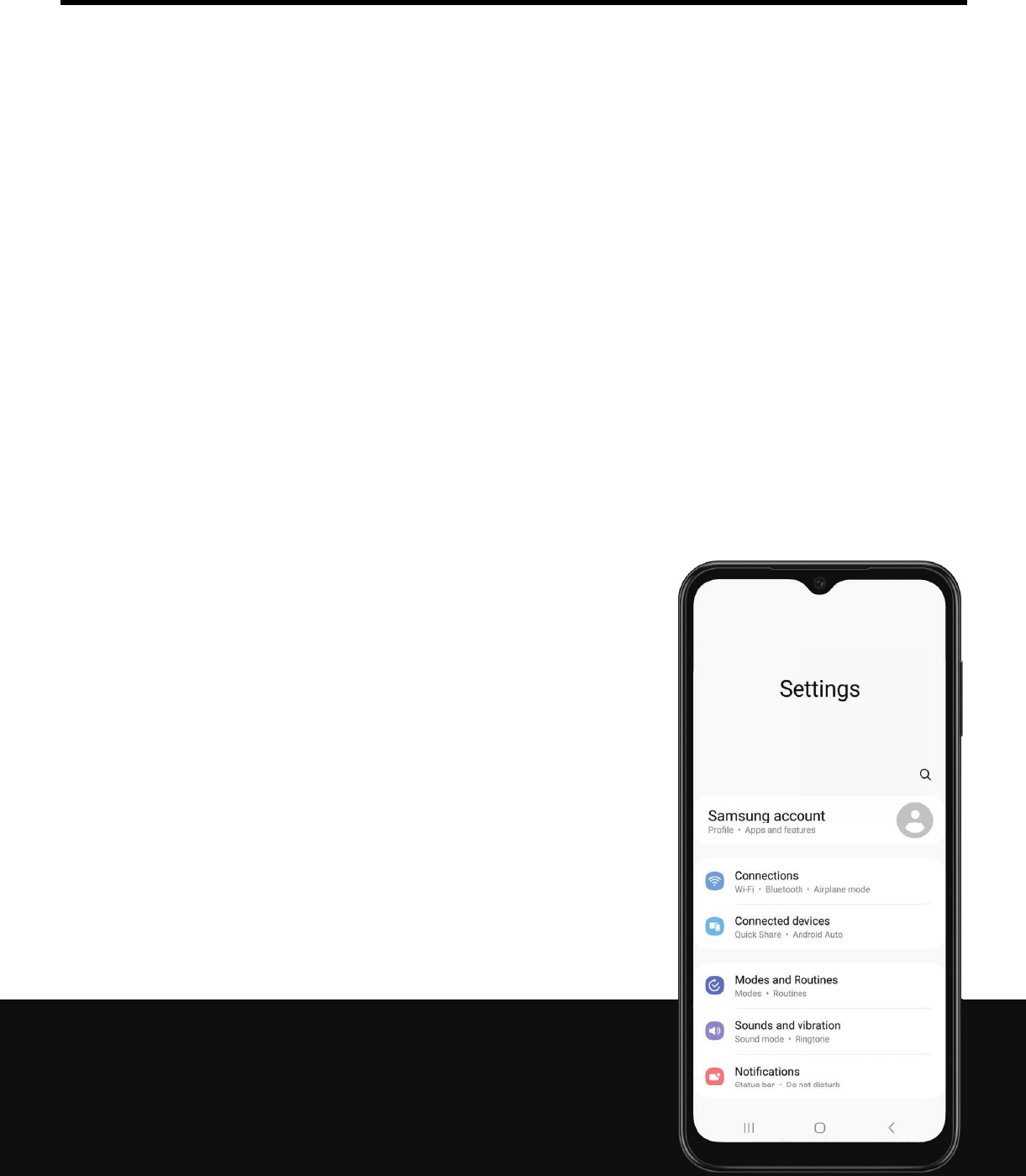
User manual

Contents
Features
Biometric security| Dark mode
Getting started
Device layout: Galaxy A14 5G
Set up your device: Charge the battery
Start using your device: Turn on your device| Use the Setup Wizard| Bring data from an
old device| Lock or unlock your device| Side key settings| Accounts| Set up voicemail|
Navigation| Navigation bar| Customize your home screen| Modes and Routines |
Digital wellbeing and parental controls| Biometric security| Mobile continuity| Multi
window| Edge panels| Enter text
Customize your home screen: App icons| Wallpaper| Themes| Icons| Widgets| Home
screen settings| Status bar| Notification panel | Quick settings
Camera and Gallery
Camera: Navigate the camera screen| Configure shooting mode| AR Zone| Record
videos| Camera settings
Gallery: View pictures| Edit pictures| Play video| Edit video| Share pictures and videos|
Delete pictures and videos| Take a screenshot
Samsung apps
ARZone| Galaxy Store| Galaxy Wearable| Game Launcher| SmartThings|
Calculator| Calendar| Clock| Contacts| Internet| Messages| MyFiles| Phone|
Samsung Notes
2
SAM_A146_EN_UM_TN_VK6_122822_FINAL

Google apps
Chrome| Drive| Gmail| Google| Google TV| Maps| Meet| Messages | Photos| Play
Store| YouTube| YT Music
Microsoft apps
Outlook| Office | OneDrive
Settings
Connections: Wi-Fi| Bluetooth| NFC and payment| Airplane mode| Mobile networks|
Data usage| Mobile hotspot| Tethering| Nearby device scanning| Connect to a
printer| Virtual Private Networks| Private DNS| Ethernet
Customization: Display| Notifications| Sounds and vibration
Security: Lock screen and security| Face recognition| Fingerprint scanner
Accounts: Add an account| Account settings| Remove an account| Backup and
restore| Google settings
Backup: Samsung account| Google Account| External storage transfer
Accessibility: Recommended for you | TalkBack| Spoken assistance | Visibility
enhancements | Hearing enhancements| Interaction and dexterity| Advanced
settings| Installed apps| About Accessibility| Contact us
Other: User manual | Android Auto| Dual Messenger | Medical info | SmartThings | Quick
Share| Labs | About phone
Learn more
Legal information
Contents
3

Galaxy A14 5G
Front camera
Headset jack
Volume keys
Microphone
Rear camera
Side key
Microphone
Speaker
F
lash
USB/charger port
Getting started
5
Devices and software are constantly evolving — the illustrations you see here are for reference only.

Set up your device
Charge the battery
Your device uses a nano-SIM card. A SIM card may be preinstalled, or you may be able
to use your previous SIM card. Network indicators for 5G service are based on your
service provider’s specifications and network availability. Contact your service
provider for more details.
SIM
microSD
Install SIM/microSD card
Place the SIM card and
optional microSD™ card
(sold separately) into the
tray with the gold
contacts facing down.
Charge your device
B
efore turning on your
device, charge it fully.
Getting started
6
Devices and software are constantly evolving — the illustrations you see here are for reference only.

Charge the battery
Your device is powered by a rechargeable battery.
NOTE Wall charger sold separately. Use only Samsung-approved chargers and
cables. To avoid injury or damage to your device, do not use incompatible, worn
or damaged batteries, chargers or cables. Using other charging devices and
batteries may not be covered under warranty and may cause damage. For
more information on your device, including charging compatibility, please visit
samsung.com.
TIPWhile charging, the device and the charger may become hot and stop
charging. Thisusually does not affect the device’s lifespan or performance and is
in the device’s normal range of operation. Disconnect the charger from the device
and wait for the device to cool down. Formore information, visit
samsung.com/us/support/answer/ANS00076952.
Start using your device
Turn on your device| Use the Setup Wizard| Bring data from an old device| Lock or
unlock your device| Side key settings| Accounts| Set up voicemail| Navigation|
Navigation bar| Customize your home screen| Modes and Routines | Digital wellbeing
and parental controls| Biometric security| Mobile continuity| Multi window| Edge
panels| Enter text
Turn on your device
Use the Side key to turn your device on. Do not use the device if the body is cracked or
broken. Use the device only after it has been repaired.
◌
Press and hold the Side key to turn the device on.
•
To turn the device off, press and hold the Side and Volume down keys at the
same time, and tap Power off. Confirm when prompted.
•
To restart your device, press and hold the Side and Volume down keys at the
same time, and tap Restart. Confirm when prompted.
7
Getting started

NOTEBest 5G performance requires optimal 5G connection and unobstructed
antennas (rear of device); see service provider for network availability; 5G
performance may be impacted by a case or cover.
Use the Setup Wizard
The first time you turn your device on, the Setup Wizard guides you through the basics
of setting up your device.
Follow the prompts to choose a default language, connect to a Wi-Fi
®
network, set up
accounts, choose location services, learn about your device’s features, and more.
Bring data from an old device
Download Smart Switch
™
to transfer contacts, photos, music, videos, messages, notes,
calendars, and more from your old device. Smart Switch can transfer your data via
USBcable, Wi-Fi, or computer.
Visit samsung.com/smartswitch for more information.
1.
From Settings, tap Accounts and backup > Bring data from old device.
2. Follow the prompts and select the content to transfer.
8
Getting started
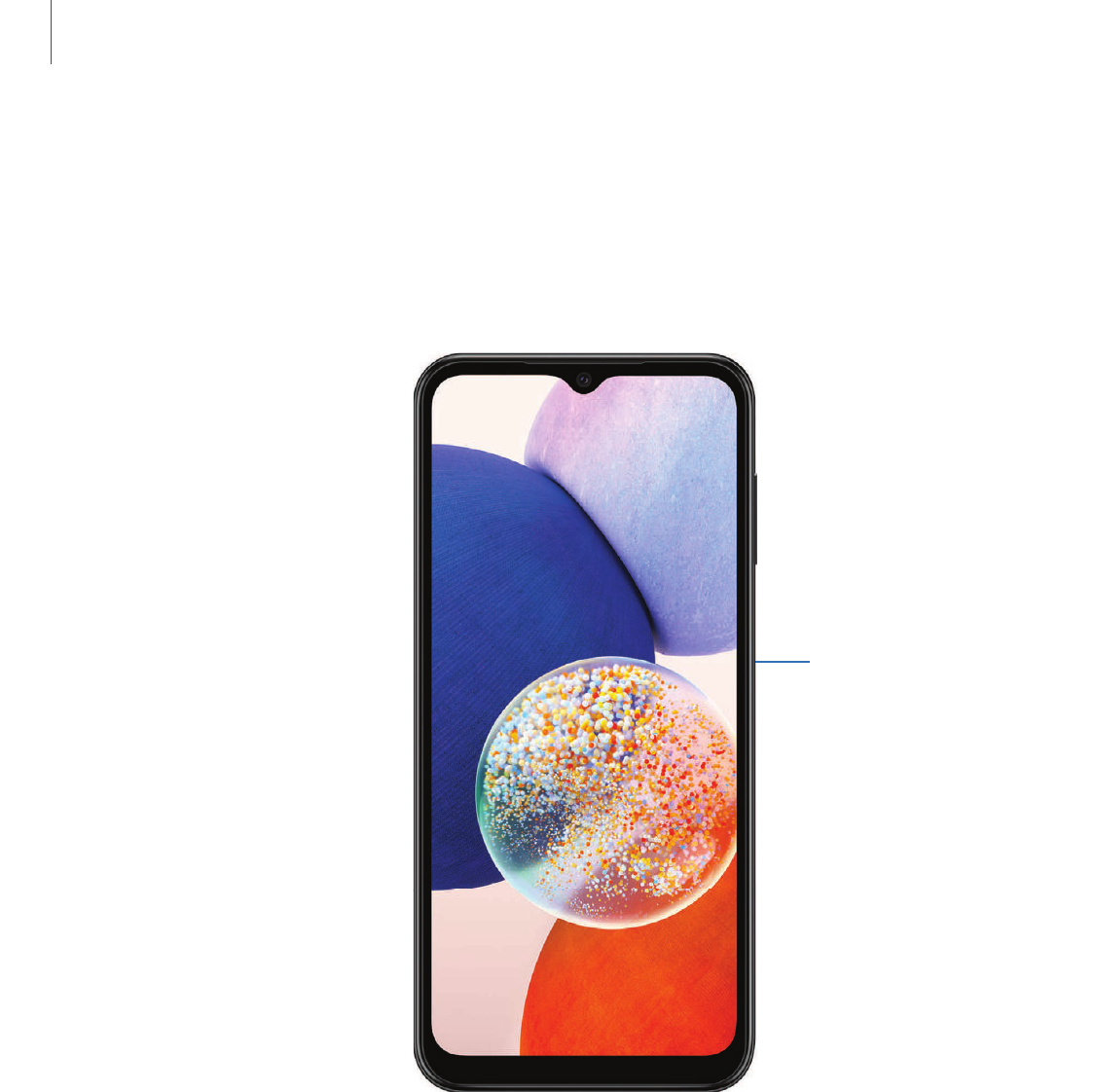
Lock or unlock your device
Use your device’s screen lock features to secure your device. By default, the device
locks automatically when the screen times out. For more information about screen
locks, see Lock screen and security.
Side key/Fingerprint
scanner
Press to lock.
Press to turn on the
screen, and then
swipe the screen to
unlock it.
Getting started
9
Devices and software are constantly evolving — the illustrations you see here are for reference only.

Side key settings
You can customize the shortcuts assigned to the Side key.
Double press
Choose which feature is launched when the Side key is pressed twice.
1.
From Settings, tap Advanced features > Side key.
2. Tap Double press to enable this feature, and tap an option:
l
Quick launch camera (default)
l
Open app
Accounts
Set up and manage your accounts.
TIPAccounts may support email, calendars, contacts, and other features.
Contact your service provider for more information.
Add a Google Account
Sign in to your Google Account to access your Google Cloud Storage, apps installed
from your account, and make full use of your device’s Android
™
features.
When you sign in to a Google Account and set a Lock screen, Google Device
Protection is activated. This service requires your Google Account information when
resetting to factory settings. For more information, see Google Play Protect.
1.
From Settings, tap Accounts and backup > Manage accounts.
2.
Tap Add account > Google.
Add a Samsung account
Sign in to your Samsung account to access exclusive Samsung content and make full
use of Samsung apps.
◌
From Settings, tap Samsung account.
10
Getting started

Add an Outlook account
Sign in to your Outlook
®
account to view and manage email messages.
1.
From Settings, tap Accounts and backup > Manage accounts.
2.
Tap Add account > Outlook.
Set up voicemail
You can set up your voicemail service when you access it for the first time. You can
access voicemail through the Phone app. Options may vary by service provider.
1.
From Phone, touch and hold the 1 key or tap Voicemail.
2. Follow the tutorial to create a password, record a greeting, and record your
name.
11
Getting started

Navigation
A touch screen responds best to a light touch from the pad of your finger or a
capacitive stylus. Using excessive force or a metallic object on the touch screen may
damage the surface of the screen and the damage will not be covered by the
warranty.
Tap
Lightly touch items to select or launch them.
l
Tap an item to select it.
l
Double-tap an image to zoom in or out.
Getting started
12
Devices and software are constantly evolving — the illustrations you see here are for reference only.
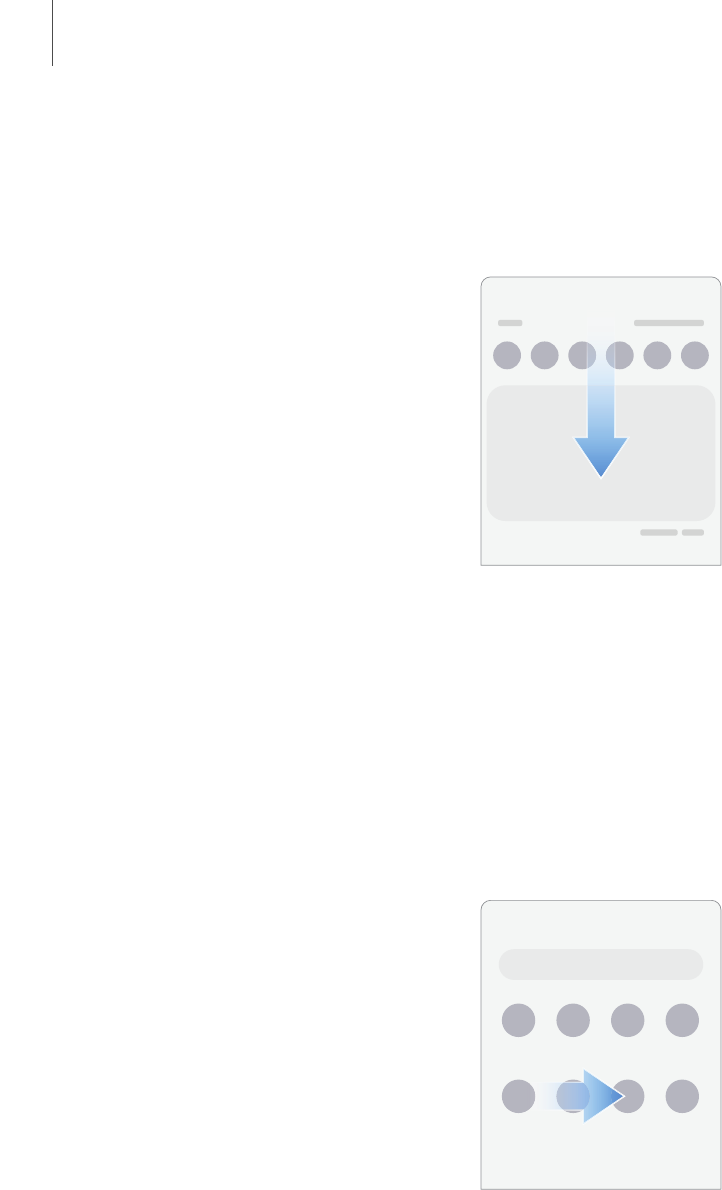
Swipe
Lightly drag your finger across the screen.
l
Swipe the screen to unlock the device.
l
Swipe the screen to scroll through the Home screens or menu options.
Drag and drop
Touch and hold an item, and then move it to a new location.
l
Drag an app shortcut to add it to a Home screen.
l
Drag a widget to place it in a new location.
Getting started
13
Devices and software are constantly evolving — the illustrations you see here are for reference only.

Zoom in and out
Bring your thumb and forefinger together or apart on the screen to zoom in and out.
l
Move your thumb and forefinger apart on the screen to zoom in.
l
Move your thumb and forefinger together on the screen to zoom out.
Touch and hold
Touch and hold items to activate them.
l
Touch and hold a field to display a pop-up menu of options.
l
Touch and hold a Home screen to customize the Home screen.
Getting started
14
Devices and software are constantly evolving — the illustrations you see here are for reference only.

Navigation bar
You may navigate your device by using either the navigation buttons or full screen
gestures.
Recent apps
H
ome
Back
Getting started
15
Devices and software are constantly evolving — the illustrations you see here are for reference only.

Navigation buttons
Use buttons along the bottom of the screen for quick navigation.
1.
From Settings, tap Display > Navigation bar > Buttons.
2. Tap an option under Button order to choose which side of the screen the Back
and Recent apps icons display.
Navigation gestures
Hide the navigation buttons at the bottom of the screen for an unobstructed screen
experience. Instead swipe to navigate your device.
1.
From Settings, tap Display > Navigation bar > Swipe gestures to enable the
feature.
2. Tap an option to customize:
l
More options: Choose a gesture type and sensitivity.
l
Gesture hint: Display lines at the bottom of the screen where each screen
gesture is located.
–
Switch apps when hint hidden: When gesture hint is disabled, you can still
switch between apps using the gesture when this option is enabled.
l
Show button to hide keyboard: Show an icon on the bottom right corner of the
screen to hide the keyboard when the device is in portrait mode.
Customize your home screen
The Home screen is the starting point for navigating your device. You can place your
favorite apps and widgets here, in addition to setting up additional Home screens,
removing screens, changing the order of screens, and choosing a main Home screen.
App icons| Wallpaper| Themes| Icons| Widgets| Home screen settings| Status bar|
Notification panel | Quick settings
App icons
Use app icons to launch an app from any Home screen.
◌
From Apps, touch and hold an app icon, and tap Add to Home.
16
Getting started

To remove an icon:
◌
From a Home screen, touch and hold an app icon, and then tap Remove.
NOTERemoving an icon does not delete the app, it just removes the icon from a
Home screen.
Wallpaper
Change the look of the Home and Lock screens by choosing a favorite picture, video,
or preloaded wallpaper.
1.
From a Home screen, touch and hold the screen, and then tap Wallpaper and
style.
2. Tap one of the following menus for available wallpapers:
•
Tap the Lock screen and Home screen images to edit them.
•
Browse my wallpapers: Choose from a variety wallpaper options, or
download more from Galaxy Themes.
•
Color palette: Choose a palette based on colors from your wallpaper.
•
Apply Dark mode to Wallpaper: Enable to apply Dark mode to your wallpaper.
Themes
Set a theme to be applied to your Home and Lock screens, wallpapers, and app icons.
1. From a Home screen, touch and hold the screen.
2.
Tap Themes, and tap a theme to preview and download it.
3.
Tap Menu > My stuff > Themes to see downloaded themes.
4. Tap a theme, and then tap Apply to apply the selected theme.
17
Getting started

Icons
Apply different icon sets to replace the default icons.
1. From a Home screen, touch and hold the screen.
2.
Tap Themes > Icons, and tap an icon set to preview and download it.
3.
Tap Menu > My stuff > Icons to see downloaded icons.
4. Tap an icon, and then tap Apply to apply the selected icon set.
Widgets
Add widgets to your home screens for quick access to info or apps.
1. From a Home screen, touch and hold the screen.
2.
Tap Widgets, and then tap a widget set to open it.
3. Swipe to the widget you want to add to the Home screen, and tap Add.
Customize Widgets
Once you have added a widget, you can customize where it's located and how it
functions.
◌
From a Home screen, touch and hold a widget, and tap an option:
•
Create stack: Add other widgets of the same size to stack in the same
place on the screen.
•
Remove: Delete a widget from your screen.
•
Settings: Customize the function or appearance of the widget.
•
App info: Review the widget usage, permissions, and more.
18
Getting started

Home screen settings
Customize your Home and Apps screens.
1. From a Home screen, touch and hold the screen.
2.
Tap Settings to customize:
•
Home screen layout: Set your device to have separate Home and Apps
screens, or only a Home screen where all apps are located.
•
Home screen grid: Choose a layout to determine how icons are arranged on
the Home screen.
•
Apps screen grid: Choose a layout to determine how icons are arranged on
the Apps screen.
•
Folder grid: Choose a layout to determine how folders are arranged.
•
Add media page to Home screen: When enabled swipe right from the Home
screen to show a media page. Tap to view available media services.
•
Show Apps screen button on Home screen: Add a button to the Home screen
for easy access to the Apps screen.
•
Lock Home screen layout: Prevent items on the Home screen from being
removed or repositioned.
•
Add new apps to Home screen: Automatically add newly-downloaded apps
to the Home screen.
•
Hide apps on Home and Apps screens: Choose apps to hide from the Home
and App screens. Return to this screen to restore hidden apps. Hidden apps
are still installed and can appear as results in Finder searches.
•
App icon badges:Enable to show badges on apps with active notifications.
You can also choose the badge style.
•
Swipe down for notification panel: Enable this feature to open the Notification
panel by swiping down anywhere on the Home screen.
•
Rotate to landscape mode:Rotate the Home screen automatically when your
device’s orientation is changed from portrait to landscape.
•
About Home screen: View version information.
•
Contact us:Contact Samsung support through Samsung Members.
19
Getting started
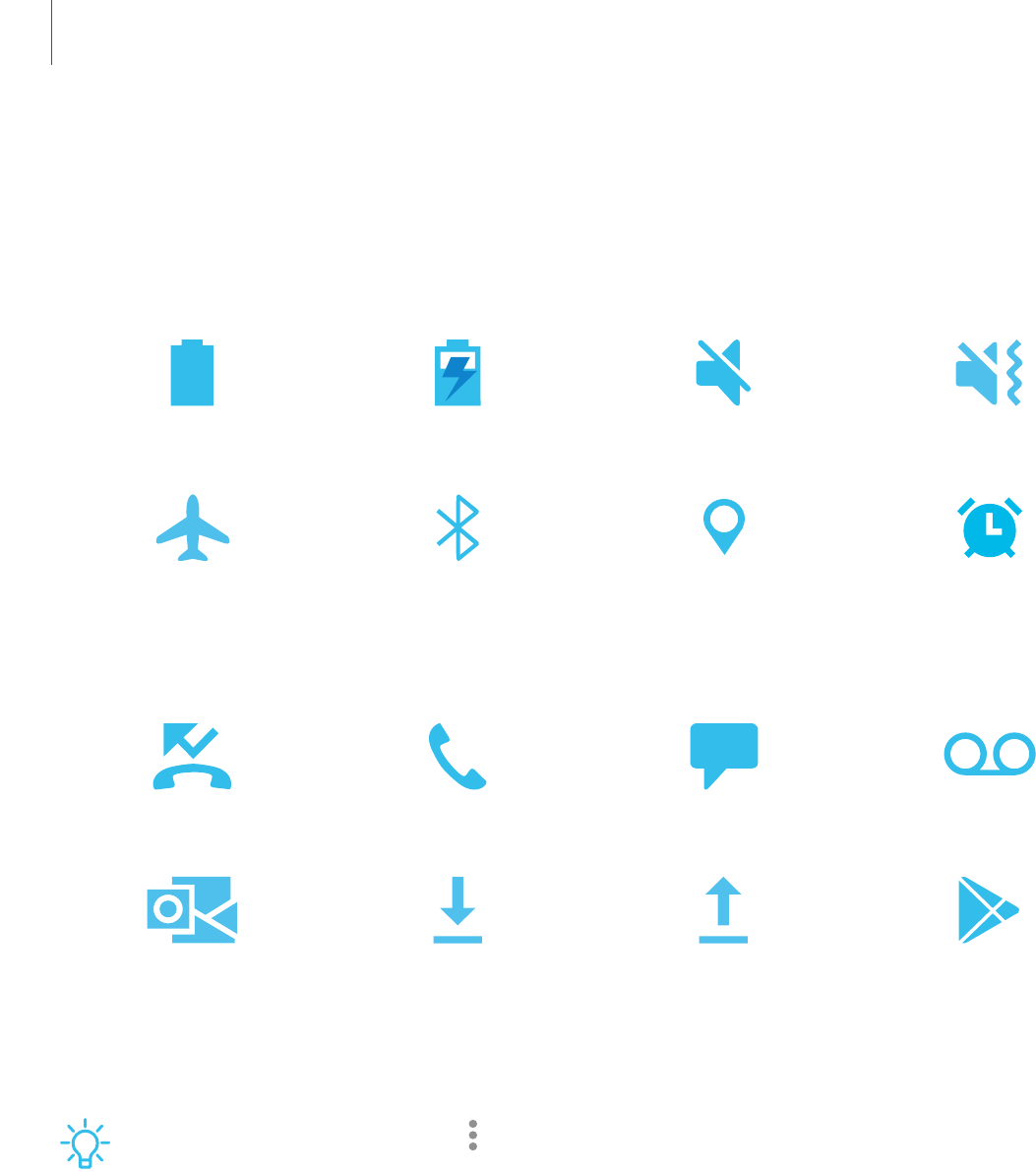
Status bar
The Status bar provides device information on the right side and notification alerts on
the left.
Status icons
Battery full Charging Mute Vibrate
Airplane mode Bluetooth active Location active Alarm
Notification icons
Missed calls Call in progress New message Voicemail
New email Download Upload App update
Configure display options for the Status bar.
TIPFrom Quick settings, tap More options > Status bar to configure settings for
Status bar notifications.
20
Getting started
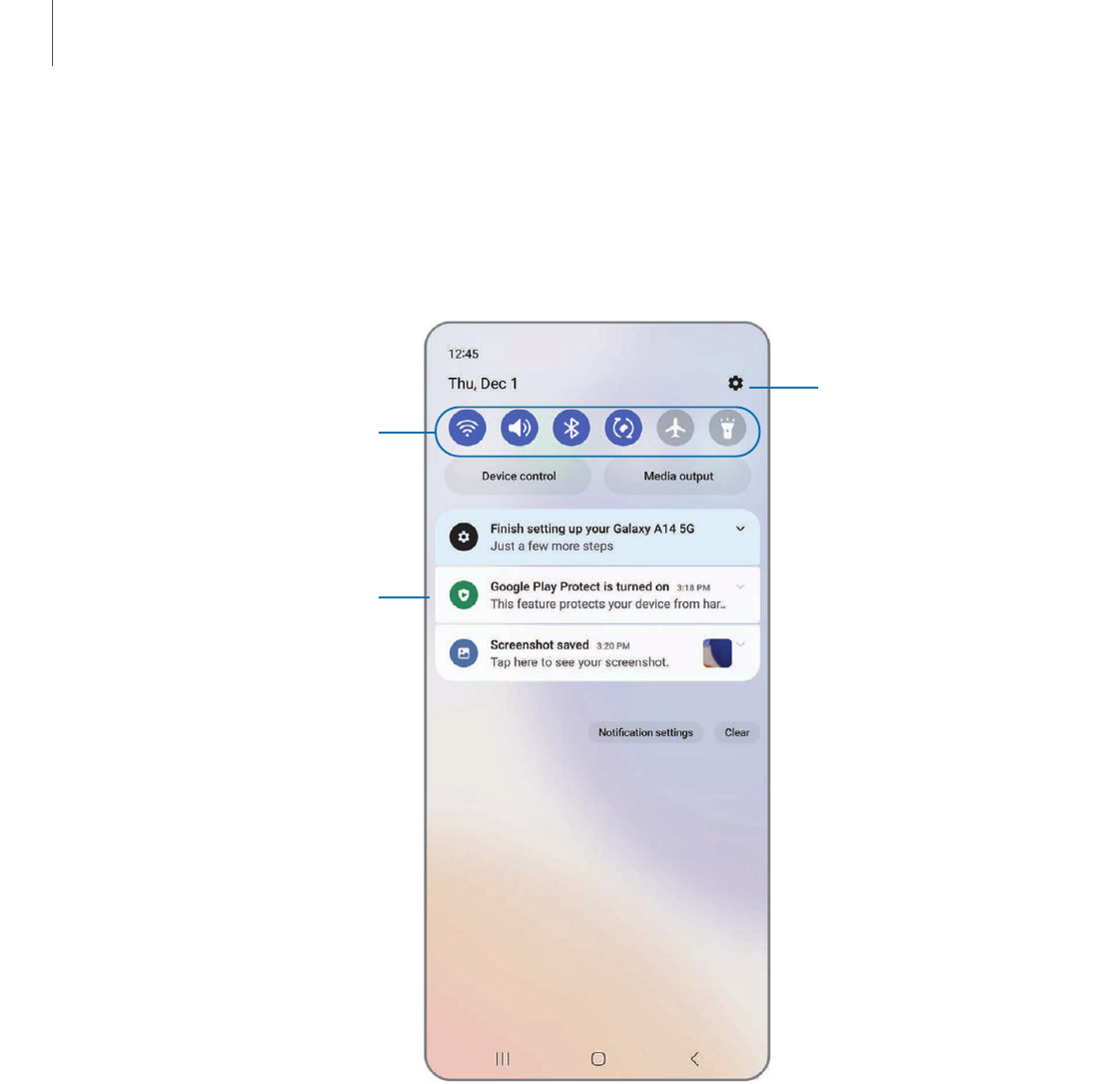
Notification panel
For quick access to notifications, settings, and more, simply open the Notification
panel.
Device settings
Quick settings
Notification cards
View the Notification panel
You can access the Notification panel from any screen.
1. Swipe down on the screen to display the Notification panel.
•
To open an item, tap it.
•
To clear a single notification, drag the notification left or right.
Getting started
21
Devices and software are constantly evolving — the illustrations you see here are for reference only.

•
To clear all notifications, tap Clear.
•
To customize notifications, tap Notification settings.
2.
Drag upward from the bottom of the screen or tap Back to close the
Notification panel.
Finger sensor gestures
You can also open or close the Notification panel by swiping up or down on the
fingerprint sensor.
1.
From Settings, tap Advanced features > Motions and gestures > Finger sensor
gestures.
2.
Tap to enable the feature.
Quick settings
The Notification panel provides quick access to device functions using Quick settings.
The icons below show the most common settings available in Quick settings. Icon
colors change when enabled and disabled. Other settings may be available on your
device.
1. Drag the Status bar down to display the Notification panel.
2. Swipe down again from the top of the screen to display Quick settings.
•
Tap a quick setting icon to turn it on or off.
•
Touch and hold a quick setting icon to open the setting.
Wi-Fi Sound Bluetooth Auto rotate
Airplane mode Location Power saving Dark mode
22
Getting started

Quick settings options
The following options are available in Quick settings.
•
Finder search: Search the device.
•
Power off: Power off and Restart options.
•
Open settings: Quickly access the device's settings menu.
•
More options: Reorder Quick settings or change the button layout.
•
Device control: Control other devices when supported apps like SmartThings or
Google Home are installed.
•
Media output: Access the Media panel and control playback of connected audio
and video devices.
•
Brightness slider: Drag to adjust the screen brightness.
Modes and Routines
Set up modes and routines to automatically change your device's settings to match
your activity or situation.
◌
From Settings, tap Modes and Routines for the following pages:
•
Modes: Choose a mode based on what you are doing or where you are.
•
Routines:Create phone routines based on times or places.
Digital wellbeing and parental controls
You can monitor and manage your digital habits by getting a daily view of how
frequently you use apps, how many notifications you receive, and how often you
check your device. You can also set your device to help you wind down before going
to bed.
◌
From Settings, tap Digital Wellbeing and parental controls for the following
features:
•
Tap the Dashboard to view the following:
–
Screen time: View how long an app has been opened and used each day.
–
Notifications received: View how many notifications have been received
from an app each day.
23
Getting started

–
Times opened/Unlocks: View how many times an app has been opened
each day.
•
Screen time goal: Set a screen time goal and view your daily average.
•
App timers: Set a daily limit for how long you use each app.
•
Driving monitor: Monitor your screen time while connected to your car's
bluetooth and see which apps you use the most.
•
Volume monitor: Choose a sound source to monitor the volume and keep
your ears safe.
•
Parental controls:Supervise your children’s digital life with Google’s Family
Link app. You can choose apps, set content filters, keep an eye on screen
time, and set screen time limits.
Biometric security
Use biometrics to securely unlock your device and log in to accounts.
Face recognition
You can enable Face Recognition to unlock your screen. To use your face to unlock
your device, you must set a pattern, PIN, or password.
•
Face recognition is less secure than Pattern, PIN, or Password. Your device could
be unlocked by someone or something that looks like your image.
•
Some conditions may affect face recognition, including wearing glasses, hats,
beards, or heavy make-up.
•
When registering your face, ensure that you are in a well-lit area and the camera
lens is clean.
1.
From Settings, tap Security and privacy > Biometrics > Facerecognition.
2. Follow the prompts to register your face.
24
Getting started

Face recognition management
Customize how face recognition works.
◌
From Settings, tap Security and privacy > Biometrics > Facerecognition.
•
Remove face data: Delete existing faces.
•
Face unlock: Enable or disable face recognition security.
•
Stay on Lock screen until swipe: When you unlock your device with face
recognition, stay on the Lock screen until you swipe the screen.
•
Brighten screen:Increase the screen brightness temporarily so that your
face can be recognized in dark conditions.
•
About face recognition: Learn additional information about securing your
device with face recognition.
Fingerprint scanner
Use fingerprint recognition as an alternative to entering passwords in certain apps.
You can also use your fingerprint to verify your identity when logging in to your
Samsung account. To use your fingerprint to unlock your device, you must set a
pattern, PIN, or password.
1.
From Settings, tap Security and privacy > Biometrics > Fingerprints.
2. Follow the prompts to register your fingerprint.
Fingerprint management
Add, delete, and rename fingerprints.
◌
From Settings, tap Security and privacy > Biometrics > Fingerprints for the
following options:
•
The list of registered fingerprints is at the top of this list. You can tap a
fingerprint to remove or rename it.
•
Add fingerprint: Simply follow the prompts to register another fingerprint.
•
Check added fingerprints: Scan your fingerprint to see if it has been
registered.
25
Getting started

Fingerprint verification settings
Use fingerprint recognition to verify your identity in supported apps and actions.
◌
From Settings, tap Security and privacy > Biometrics > Fingerprints.
•
Fingerprint unlock: Use your fingerprint for identification when unlocking your
device.
•
Fingerprint always on: Scan your fingerprint even when the screen is off.
•
Use to sign in to websites: Use your fingerprints to sign in to websites.
•
Use for Samsung account verification: Use your fingerprints to verify your
identity instead of your Samsung account password.
Biometrics settings
Configure your preferences for biometric security options.
◌
From Settings, tap Security and privacy > Biometrics for the following:
•
Show unlock transition effect:Show a transition effect when you use
biometrics to unlock your device.
•
About unlocking with biometrics: Learn additional information about securing
your device with biometrics.
Mobile continuity
Access storage and other functions of your device across compatible mobile devices
and computers.
Call and text on other devices
This feature allows you to make and answer calls and text messages from your
Galaxy devices that are signed in to your Samsung account.
1.
From Settings, tap Connected devices > Call & text on other devices.
2.
Tap to turn on the feature. Connection occurs automatically.
3. Sign in to your Samsung account on your Galaxy devices.
TIPMove your contacts from your device to your Samsung account so you can
access them on all registered devices.
26
Getting started
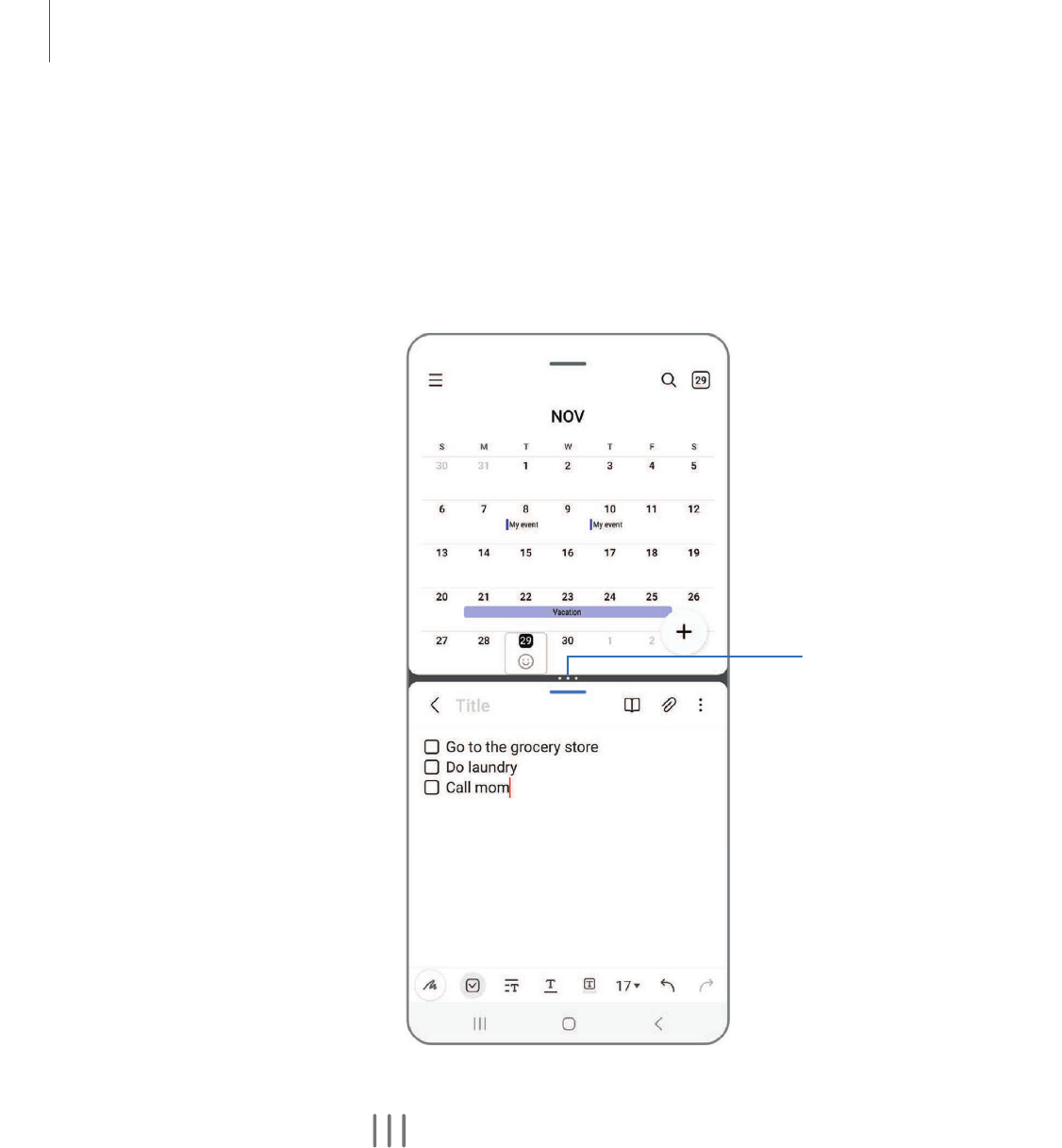
Multi window
Multitask by using multiple apps at the same time. Apps that support Multi window
™
can be displayed together on a split screen. You can switch between the apps and
adjust the size of their windows.
Split screen control
1.
From any screen, tap Recent apps.
2. Tap the app icon, and then tap Open in split screen view.
3. Tap an app in the other window to add it to the split screen view.
•
Drag the middle of the window border to adjust the window size.
Getting started
27
Devices and software are constantly evolving — the illustrations you see here are for reference only.

Window controls
The Window controls modify the way app windows are displayed in split screen view.
1. Drag the middle of the window border to resize the windows.
2. Tap the middle of the window border for the following options:
•
Switch window: Swap the two windows.
•
Add app pair to: Create and add an app pair shortcut to the Apps panel on
the Edge screen.
28
Getting started

Edge panels
The Edge panels feature a variety of customizable panels that can be accessed from
the edge of the screen. Edge panels can be used to access apps, tasks, and contacts,
as well as view news, sports, and other information.
Apps panel | Configure Edge panels | Edge panel position and style| About Edge panels
◌
From Settings, tap Display > Edge panels, tap to enable this feature.
Edge handle
Swipe to the center
of the screen to
open the Edge
panels.
Apps panel
You can add apps to the Appspanel.
1. From any screen, drag the Edge handle to the center of the screen. Swipe until
the Apps panel is displayed.
2.
Tap an app or app pair shortcut to open it. You can also tap All apps for the
complete app list.
l
To open additional windows in pop-up view, drag the app icon from the Apps
panel to the open screen.
Getting started
29
Devices and software are constantly evolving — the illustrations you see here are for reference only.

To configure Apps panel:
1. From any screen, drag the Edge handle tothe center of the screen. Swipe until
the Appspanel is displayed.
2.
Tap Edit to add other apps to the Appspanel.
•
To add an app to the Apps panel, find it on the left side of the screen and tap it
to add it to an available space on the right column.
•
To create a folder shortcut, drag an app from the left side of the screen on
top of an app in the columns on the right.
•
To change the order of the apps on the panel, drag each app to the desired
location.
•
To remove an app, tap Remove.
3.
Tap Back to save changes.
Configure Edge panels
You can customize the Edge panels.
1.
From Settings, tap Display > Edge panels > Panels.
2. The following options are available:
•
Checkbox: Enable or disable each panel.
•
Edit (if available): Configure individual panels.
•
Search: Find panels that are either installed or available to install.
•
More options:
–
Reorder: Change the order of the panels by dragging them to the left or
right.
–
Uninstall: Remove a downloaded Edgepanel from your device.
–
Hide on Lock screen: Choose panels to hide on the Lock screen when a
secure screen lock is set.
30
Getting started

•
Galaxy Store: Search for and download more Edge panels from Galaxy
Store.
3.
Tap Back to save changes.
Edge panel position and style
You can change the position of the Edge handle.
◌
From Settings, tap Display > Edge panels >Handle for the following options:
•
Edge handle: Drag to change the position of the Edge handle along the
edge of the screen.
•
Position: Choose either Right or Left to set which side the Edge screen
displayson.
•
Lock handle position:Enable to prevent the handle position from being
moved when touched and held.
•
Style: Choose a color for the Edge handle.
•
Transparency: Drag the slider to adjust the transparency of the Edge handle.
•
Size: Drag the slider to adjust the size of the Edge handle.
•
Width: Drag the slider to adjust the width of the Edge handle.
•
Vibrate when handle is touched: Vibrate when the Edge handle is touched.
About Edge panels
You can view the current software version and license information for the Edge
panels feature.
◌
From Settings, tap Display > Edge panels > AboutEdge panels.
31
Getting started
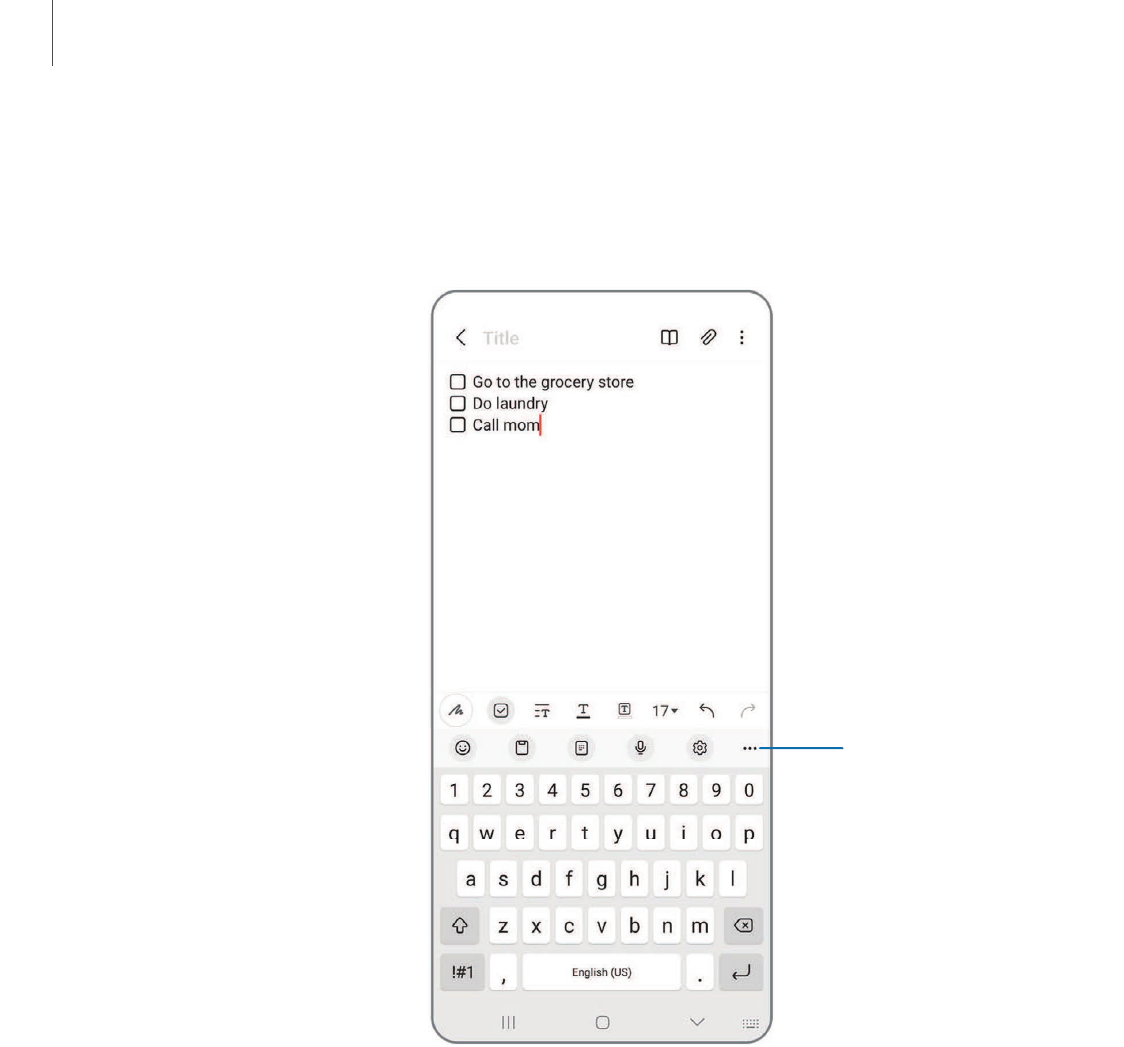
Enter text
Text can be entered using a keyboard or your voice.
Expand toolbar
Getting started
32
Devices and software are constantly evolving — the illustrations you see here are for reference only.

Toolbar
The toolbar provides quick access to features of the keyboard. Options may vary by
service provider.
◌
From the Samsung keyboard, tap Expand toolbar for the following options:
•
Expression: Explore different types of emojis, GIFs, create custom
combined emojis, and more.
•
Clipboard: Access the clipboard.
•
One-handed keyboard: Switch to a layout for one-handed use.
•
Voice input:Use Samsung voice input.
•
Settings: Access keyboard settings.
•
Split keyboard: Change the keyboard to a split version that is separated.
•
Floating keyboard: Change the keyboard to a floating version that can be
moved anywhere on the screen.
•
Search: Locate specific words or phrases in your conversations.
•
Translate: Type words or sentences in the keyboard to translate them
into another language.
•
Grammarly:Get suggestions from Grammarly as you type.
•
Emojis: Insert an emoji.
•
GIFs: Add animated GIFs.
•
Bitmoji: Create your own personal emoji and use it in stickers.
•
Mojitok: Create your own stickers or insert automatically suggested ones.
•
AR Emoji: Create your own personal emoji and use it in stickers you can
share.
•
Keyboard size: Adjust the height and width of the keyboard.
•
Text editing: Use an editing panel to help pinpoint text that you want to
cut, copy, and paste.
33
Getting started

Configure the Samsung keyboard
Set customized options for the Samsung keyboard.
◌
From the Samsung keyboard, tap Settings for the following options:
•
Languages and types: Set the keyboard type and choose which languages
are available on the keyboard.
–
To switch between languages, swipe the Space bar left or right.
Smart typing
•
Predictive text: As you type see suggested words and phrases.
•
Suggest emojis: Include emojis when using predictive text.
•
Suggest stickers while typing: View recommended stickers while you are
typing.
•
Auto replace: Automatically replace what you type with predictive text
recommendations.
•
Suggest text corrections: Underline misspelled words in red and suggest
corrections.
•
Text shortcuts: Create shortcuts for frequently used phrases.
•
More typing options: Customize additional typing options.
Style and layout
•
Keyboard toolbar: View or hide the keyboard toolbar.
•
High contrast keyboard: Adjust the size of the Samsung keyboard and
change its colors to increase the contrast between the keys and the
background.
•
Theme: Choose a theme for your keyboard.
•
Mode: Choose between portrait and landscape mode.
•
Size and transparency: Adjust the size and transparency of the keyboard.
•
Layout: Display numbers and special characters on the keyboard.
•
Font size: Drag the slider to adjust the font size.
•
Custom symbols: Change the symbol shortcuts on the keyboard.
34
Getting started

Other settings
•
Voice input: Configure voice input services and settings.
•
Swipe, touch, and feedback: Customize gestures and feedback.
•
Save screenshots to clipboard:Enable saving screenshots to the keyboard
clipboard.
•
Select third-party content to use: Enable third-party keyboard features.
•
Reset to default settings: Return keyboard to original settings and clear
personalized data.
•
About Samsung keyboard: View version and legal information for the
Samsung keyboard.
•
Contact us: Contact Samsung support through Samsung Members.
35
Getting started

36
Devices and software are constantly evolving — the illustrations you see here are for reference only.
Camera and Gallery
You can capture high-quality pictures and videos using the Camera app. Images and
videos are stored in the Gallery, where you can view and edit them.
Camera
Navigate the camera screen| Configure shooting mode| AR Zone| Record videos|
Camera settings
Gallery
View pictures| Edit pictures| Play video| Edit video| Share pictures and videos|
Delete pictures and videos| Take a screenshot

Camera
Enjoy a full kit of pro lenses and pro-grade video modes and settings.
◌
From Apps, tap Camera.
TIPQuickly press the Side key twice to open the Camera app.
Shooting modes
S
ettings
Gallery
Switch cameras
Capture
Zoom
Camera and Gallery
37
Devices and software are constantly evolving — the illustrations you see here are for reference only.

Navigate the camera screen
Take stunning pictures with your device’s front and rear cameras.
1.
From Camera, set up your shot with the following features:
•
Tap the screen where you want the camera to focus.
–
When you tap the screen, a brightness scale appears. Drag the slider to
adjust the brightness.
•
To quickly switch between the front and rear cameras, swipe the screen up
or down.
•
To zoom at a precise level, tap 1x and tap an option at the bottom of the
screen. (Only available when using the rear camera.)
•
To change to a different shooting mode, swipe the screen right or left.
•
To change camera settings, tap Settings.
2.
Tap Capture.
Configure shooting mode
Allow the camera to determine the ideal mode for your pictures or choose from
several shooting modes.
◌
From Camera, swipe the screen right and left to change shooting modes.
•
Portrait: Adjust the background of your shots for portrait photos.
•
Photo: Allow the camera to determine the ideal settings for pictures.
•
Video: Allow the camera to determine the ideal settings for videos.
•
More: Choose other available shooting modes. Tap Add to drag modes
into or out of the shooting modes tray at the bottom of the Camera screen.
–
Pro: Manually adjust the ISO sensitivity, exposure value, white balance, and
color tone while taking pictures.
–
Macro: Capture close-up images of objects from 3-5 cm away.
–
Panorama: Create a linear image by taking pictures in either a horizontal
or vertical direction.
–
Night: Use this to take photos in low-light conditions, without using the flash.
–
Food: Take pictures that emphasize the vivid colors of food.
38
Camera and Gallery

–
Slow motion: Record videos at a high frame rate for viewing in slow motion.
–
Hyperlapse: Create a time lapse video by recording at various frame rates.
The frame rate is adjusted depending on the scene being recorded and
the movement of the device.
AR Zone
Access all of your Augmented Reality (AR) features in one place.
◌
From Camera, swipe to More, and then tap AR Zone. The following features
are available:
•
AR Emoji Studio: Use AR tools to create and customize your My Emoji avatar.
•
AR Emoji Stickers: Add ARstickers to your My Emoji avatar.
•
Deco Pic: Decorate photos or videos in real time with the camera.
Record videos
Record smooth lifelike videos using your device.
1.
From Camera, swipe right or left to change the shooting mode to Video.
2.
Tap Record to begin recording a video.
•
To take a picture while recording, tap Capture.
•
To temporarily stop recording, tap Pause. To continue recording,
tap Resume.
3.
Tap Stop when you are finished recording.
Camera settings
Use the icons on the main camera screen and the settings menu to configure your
camera’s settings.
◌
From Camera, tap Settings for the following options:
Intelligent features
•
Scene optimizer: Automatically adjust the color settings of your pictures to
match the subject matter.
•
Scan QR codes: Automatically detect QR codes when using the camera.
39
Camera and Gallery

Pictures
•
Swipe Shutter button to: Choose to either take a burst shot or create a GIF
when you swipe the shutter to the nearest edge.
•
HEIF pictures: Save pictures as high efficiency images to save space. Some
sharing sites may not support this format.
Selfies
•
Save selfies as previewed: Save selfies as they appear in the preview without
flipping them.
Videos
•
High efficiency videos: Record videos in HEVC format to save space. Other
devices or sharing sites may not support playback of this format.
•
Video stabilization: Activate anti-shake to keep the focus steady when the
camera is moving.
General
•
Auto HDR: Capture more detail in the bright and dark areas of your shots.
•
Grid lines: Display viewfinder grid lines to help compose a picture or video.
•
Location tags: Attach a GPS location tag to your pictures and videos.
•
Shooting methods:
–
Press Volume keys to: Use the Volume keys to take pictures, record video,
zoom, or control system volume.
–
Floating shutter button: Add an extra shutter button that you can move
anywhere on the screen.
–
Show palm: Hold your hand out with your palm facing the camera to have
your picture taken in a few seconds.
•
Settings to keep: Choose whether to launch Camera with the same shooting
mode, selfie angle, and filters as the last time.
•
Storage location: Choose a location to store pictures and videos.
–
A microSD card (not included) must be installed to view Storage location.
•
Shutter sound: Play a tone when taking a picture.
40
Camera and Gallery

Privacy
l
Privacy Notice: View Samsung's privacy information.
l
Permissions: View required and optional permissions for the Camera app.
Others
l
Reset settings: Reset the Camera settings.
l
Contact us:Contact Samsung support through Samsung Members.
l
About Camera:View app and software information.
41
Camera and Gallery
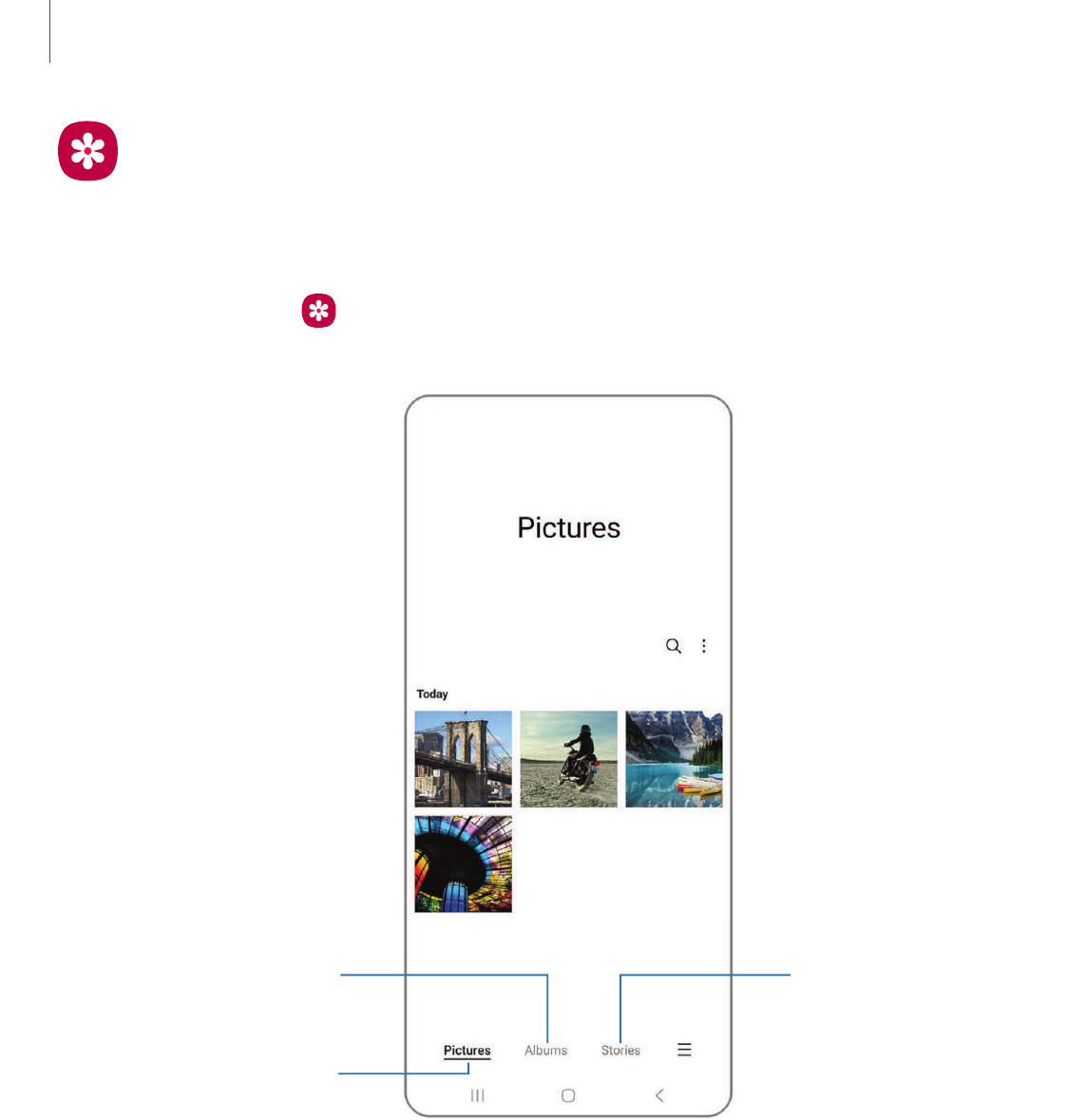
Gallery
Go to the Gallery to look at the all the visual media stored on your device. You can
view, edit, and manage pictures and videos.
◌
From Apps, tap Gallery.
Customize collections
o
f pictures and videos
View pictures
and videos
Sort images into
custom albums
Camera and Gallery
42
Devices and software are constantly evolving — the illustrations you see here are for reference only.

View pictures
Pictures stored on your device are viewable in the Gallery app.
1.
From Gallery, tap Pictures.
2. Tap a picture to view it. Swipe left or right to view other pictures or videos.
•
To mark the picture as a favorite, tap Add to Favorites.
•
To access the following features, tap More options:
–
Details: View and edit information about the picture.
–
Copy to clipboard: Copy the image to paste in another app.
–
Set as wallpaper: Set the picture as wallpaper.
–
Print: Send the picture to a connected printer.
Edit pictures
Enhance your pictures using the Gallery's editing tools.
1.
From Gallery, tap Pictures.
2.
Tap a picture to view it, and then tap Edit for the following options:
•
Transform: Rotate, flip, crop, or make other changes to the overall
appearance of the picture.
•
Filters: Add color effects.
•
Tone: Adjust the brightness, exposure, contrast, and more.
•
Decorations: Add text, stickers, or hand drawn content.
•
Revert:Undo the changes applied to restore the original picture.
3. Tap Save when finished.
43
Camera and Gallery

Play video
View the videos stored on your device. You can save videos as favorites, and view
video details.
1.
From Gallery, tap Pictures.
2. Tap a video to view it. Swipe left or right to view other pictures or videos.
•
To mark the video as a favorite, tap Add to Favorites. The video is added to
Favorites under the Albumstab.
•
To access the following features, tap More options:
–
Details: View and edit information about the video.
–
Set as wallpaper: Set the video as wallpaper on the Lock screen.
3.
Tap Play video to play the video.
Edit video
Edit videos stored on your device.
1.
From Gallery, tap Pictures.
2. Tap a video to view it.
3.
Tap Edit to cut segments of the video.
4. Tap Save, and then confirm when prompted.
Share pictures and videos
Share pictures and videos from the Gallery app.
1.
From Gallery, tap Pictures.
2.
Tap More options > Edit and select the pictures or videos you want to share.
3.
Tap Share, and then choose an app or connection to use for sharing your
selection. Follow the prompts.
44
Camera and Gallery

Delete pictures and videos
Delete pictures and videos stored on your device.
1.
From Gallery, tap More options > Edit.
2. Tap pictures and videos to select them.
3.
Tap Delete, and confirm when prompted.
Take a screenshot
Capture an image of your screen. Your device will automatically create a Screenshots
album in the Gallery app.
◌
From any screen, press and release the Side and Volume down keys.
Screenshot settings
Modify screenshot settings.
◌
From Settings, tap Advanced features > Screenshots.
l
Show toolbar after capturing: Show additional options after you take a
screenshot.
l
Delete after sharing from toolbar: Automatically delete screenshots after
they are shared through the screenshot toolbar.
l
Hide status and navigation bars: Do not display the status bar or navigation
bars on screenshots.
l
Format: Choose if you would like your screenshots to be saved as JPG or
PNG files.
45
Camera and Gallery

Using apps
Uninstall or disable apps | Search for apps| Sort apps| Create and use folders| Game
Booster| App settings
The Apps list displays all preloaded and downloaded apps. Apps can be downloaded
from Galaxy Store and the Google Play
™
store.
◌
From a Home screen, swipe the screen upward to access the Apps list.
Uninstall or disable apps
Installed apps can be removed from your device. Some apps that are preloaded
(available on your device by default) can only be disabled. Disabled apps are turned
off and hidden from the Apps list.
◌
From Apps, touch and hold an app, and tap Uninstall/Disable.
Search for apps
If you are not sure where to find an app or a setting, you can use the Search feature.
1. From Apps, tap Search, and enter a word or words. As you type, matching apps
and settings appear as results on the screen.
2. Tap a result to go to that app.
TIPYou can customize the search settings by tapping More options > Settings.
Sort apps
App shortcuts can be listed alphabetically or in your own custom order.
◌
From Apps, tap More options > Sort for the following sorting options:
•
Custom order: Arrange apps manually.
•
Alphabetical order: Sort apps alphabetically.
TIPWhen apps are arranged manually (Custom order), empty icon spaces
can be removed by tapping More options > Clean up pages.
47
Apps

Create and use folders
You can make folders to organize App shortcuts on the Appslist.
1. From Apps, touch and hold an app shortcut, and then drag it on top of another
app shortcut until it is highlighted.
2. Release the app shortcut to create the folder.
•
Folder name: Name the folder.
•
Palette: Change the folder color.
•
Add apps: Place more apps in the folder. Tap apps to select them, and
then tap Done.
3.
Tap Back to close the folder.
Copy a folder to a Home screen
You can copy a folder to a Home screen.
◌
From Apps, touch and hold a folder, and tap Add to Home.
Delete a folder
When you delete a folder, the app shortcuts return to the Apps list.
1. From Apps, touch and hold a folder to delete.
2.
Tap Delete folder, and confirm when prompted.
Game Booster
Get optimized performance while playing games based on your usage. Block
notifications and enable features to improve your gaming experience.
◌
While playing a game, swipe up from the bottom of the screen to view the
navigation bar. The following options are seen on the far right and left sides:
•
Touch protection: Lock the screen to prevent accidental taps. This is
the default option.
•
Game Booster: Configure other options, including performance
monitoring and blocking the navigation bar, screen touches, and
screenshots.
48
Apps

App settings
Manage your downloaded and preloaded apps.
◌
From Settings, tap Apps. Tap an option to customize:
•
Choose default apps: Choose which apps to use for making calls, sending
messages, going to websites, and more.
•
Samsung app settings: View a list of Samsung apps and customize their
settings.
•
Your apps: Tap an app to view and update information about its privacy and
usage settings. Options vary by app.
TIP To reset app options that have been changed, tap More options > Reset app
preferences.
Samsung apps
The following apps may be preloaded or downloaded over-the-air to your device
during setup. Apps can be downloaded from Galaxy Store and the Google Play
™
store.
Options may vary by service provider.
ARZone| Galaxy Store| Galaxy Wearable| Game Launcher| SmartThings| Calculator|
Calendar| Clock| Contacts| Internet| Messages| MyFiles| Phone| Samsung Notes
ARZone
Access all of your Augmented Reality (AR) features in one place.
For more information, see AR Zone.
Galaxy Store
Find and download premium apps that are exclusive to Galaxy devices. A Samsung
account is required to download from Galaxy Store.
49
Apps

Wear
Galaxy Wearable
Connect your device to your Samsung Watch using this application.
For more information, visit samsung.com/us/support/owners/app/galaxy-wearable-
watch.
Game Launcher
Automatically arrange all your games in one place. Formore information on Game
Launcher, visit samsung.com/us/support/owners/app/game-launcher.
TIPIf Game Launcher is not seen in the Apps list, then from Settings, tap
Advanced features > Game Launcher, and then tap .
SmartThings
SmartThings allows you to control, automate, and monitor your home environment
through a mobile device to fit your specific needs. You can use the app to connect
multiple devices at once or one device at a time. Check the status of your devices by
looking at the dashboard.
NOTENon-Samsung connected device errors or defects are not covered by the
Samsung warranty; contact the non-Samsung device manufacturer for support.
50
Apps

Calculator
The Calculator app features both basic and scientific math functions, as well as a unit
converter.
History
View past
calculations.
Unit converter
Convert between
measurements.
Scientific mode
Apps
51
Devices and software are constantly evolving — the illustrations you see here are for reference only.
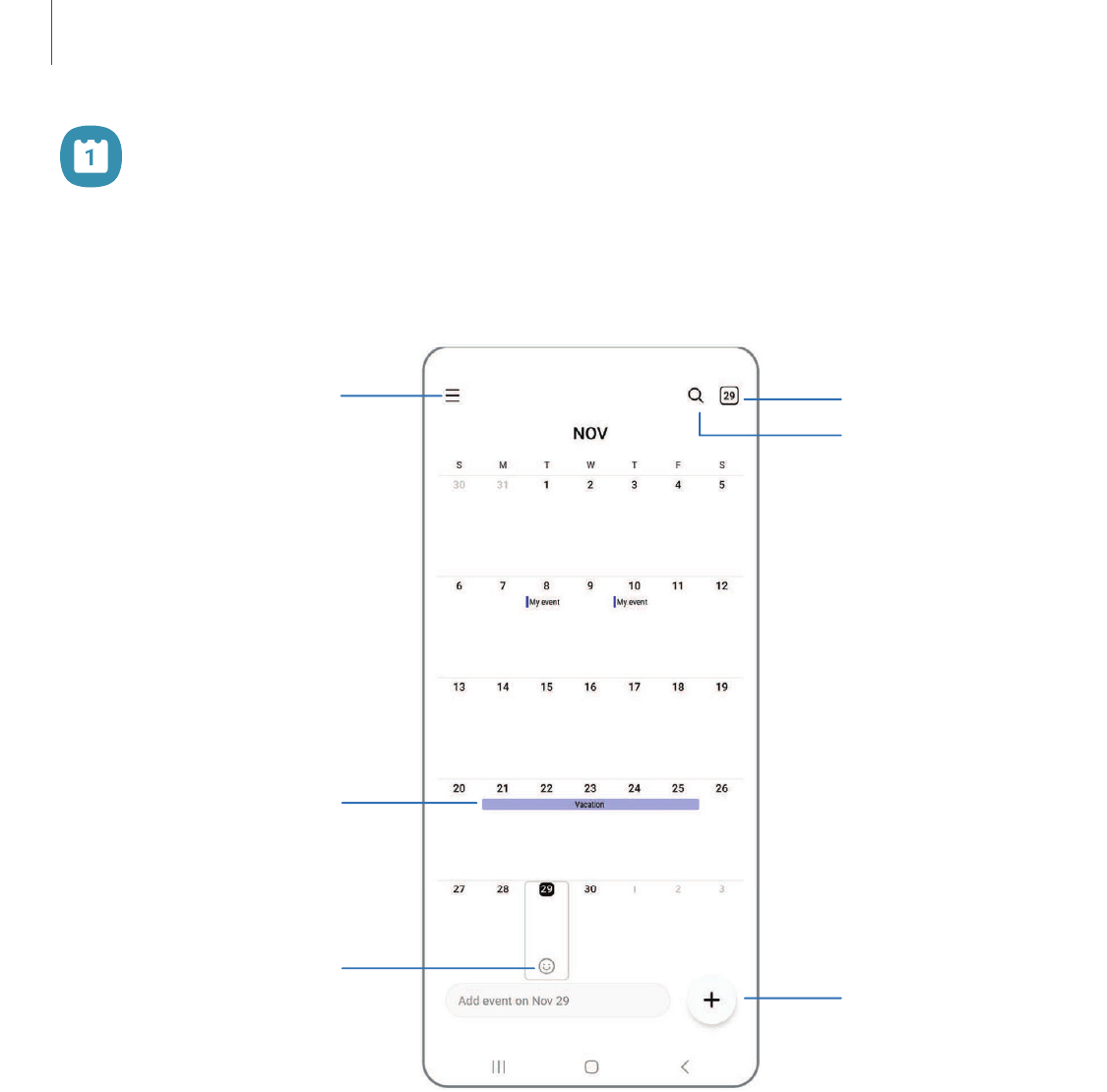
Calendar
The Calendar app can be connected to your various online accounts to consolidate
all your calendars in one place.
Tap to view event
Navigation drawer
Add detailed event
Go to today’s date
Stickers
Search
Apps
52
Devices and software are constantly evolving — the illustrations you see here are for reference only.

Add calendars
Add your accounts to the Calendar app.
1.
From Calendar, tap Navigation drawer.
2.
Tap Manage calendars > Add account and select an account type.
3. Enter your account information and follow the prompts.
TIPAccounts may also support email, contacts, and other features.
Calendar alert style
Alerts from the Calendar app can be set to different styles.
1.
From Calendar, tap Navigation drawer > Calendar settings > Alert style.
Thefollowing options are available:
•
Light: Receive a notification and hear a short sound.
•
Medium:Get a full screen alert and hear a short sound.
•
Strong:Get a full-screen alert and ring sound that persist until dismissed.
2. Depending on the alert style selected above, the following sound options are
available:
•
Short sound:Choose the alert sound for Light or Medium alert styles.
•
Long sound:Choose the alert sound for the Strong alert style.
Create an event
Use your Calendar to create events.
1.
From Calendar, tap Add detailed event to add an event.
2. Enter details for the event, and then tap Save.
Delete an event
Delete events from your Calendar.
1.
From Calendar, tap an event, and tap again to editit.
2.
Tap Delete, and confirm when prompted.
53
Apps

Clock
The Clock app offers features for keeping track of time and setting alarms.
Turn alarm on or off
Add alarm
Apps
54
Devices and software are constantly evolving — the illustrations you see here are for reference only.

Alarm
Use the Alarm tab to set one-time or recurring alarms and choose options for how to
be notified.
1.
From Clock, tap Add alarm.
2. Tap the following items to configure an alarm:
•
Time: Set a time for the alarm.
•
Day: Choose the days for this alarm.
•
Alarm name: Enter a name for the alarm.
•
Alarm sound: Choose a sound to play for the alarm and drag the slider to set
the volume of the alarm.
•
Vibration: Choose whether the alarm uses vibration alert.
•
Snooze: Allow snoozing. Set interval and repeat values for the alarm while
snoozing.
3. Tap Save to save the alarm.
TIP To add your sleep schedule, create a bedtime reminder, and automatically
put your device in Sleep mode, tap More options > Set Sleep mode schedule.
Delete an alarm
You can delete an alarm that you created.
1.
From Clock, touch and hold an alarm.
2.
Tap Delete.
Alert settings
You can set the device to vibrate for alarms and timers whether the Sound mode is
set to Mute or Vibrate.
1.
From Clock, tap More options > Settings.
2. Tap Silence alarms when system sound is off to enable the feature.
55
Apps

Alarm settings
You can receive notifications for upcoming alarms.
1.
From Clock, tap More options > Settings.
2. Tap Upcoming alarm notification to choose the number of minutes before an
upcoming alarm.
56
Apps
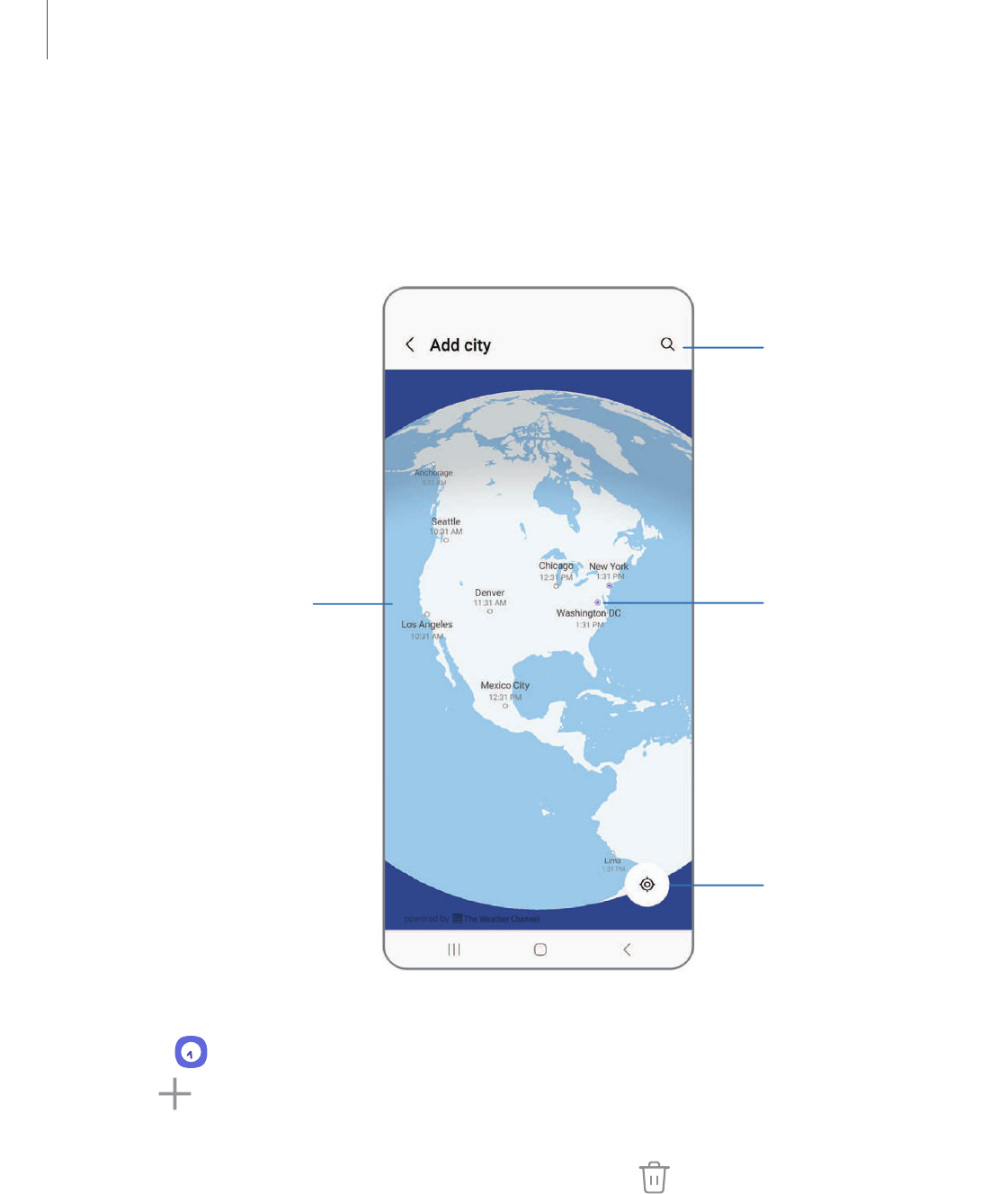
World clock
The World clock lets you keep track of the current time in multiple cities around the
globe.
Location
C
enter the globe on
your current
location.
City
View the current
time and add to
your list of cities.
Search
Find a particular
place.
Globe
Drag to spin and
see times around
the world.
1.
From Clock, tap World clock.
2.
Tap Add city.
3. Drag the globe to spin it, tap the city you want, and then tap Add.
•
To remove a city, touch and hold it, and tap Delete.
Apps
57
Devices and software are constantly evolving — the illustrations you see here are for reference only.

Time zone converter
Set a time in a city on your World clock list to see what the local times would be in the
other listed cities.
1.
From Clock, tap World clock.
2.
Tap More options > Time zone converter.
3.
Tap Menu to choose a different city.
•
To add a city to the list, tap Add city.
4. Swipe the hours, minutes, and period (AM or PM) on the clock to set a time. Local
times for the other cities listed are automatically updated.
•
To return the clock to the current time, tapReset.
Weather settings
Show weather information on your World clock.
1.
From Clock, tap World clock.
2.
Tap More options > Settings >Show weather to enable or disable weather
information.
3. Tap Temperature to change from Fahrenheit to Celsius.
Stopwatch
The Stopwatch lets you time events down to a hundredth of a second.
1.
From Clock, tap Stopwatch.
2. Tap Start to begin timing.
•
To keep track of lap times, tap Lap.
3. Tap Stop to end timing.
•
To continue timing after stopping the clock, tap Resume.
•
To reset the Stopwatch to zero, tap Reset.
58
Apps

Timer
Set a countdown timer for up to 99hours, 59minutes, and 59 seconds.
1.
From Clock, tap Timer.
2. Use the keypad and tap Hours, Minutes, and Seconds to set the Timer.
3. Tap Start to begin the Timer.
•
To temporarily stop the Timer, tap Pause. To continue, tap Resume.
•
To stop and reset the Timer, tap Delete.
Preset timer
Name and save preset timers.
1.
From Clock, tap Timer > More options > Add preset timer.
2. Configure the countdown time and timer name.
3. Tap Add to save the timer.
•
To edit a saved preset timer, tap More options > Edit preset timers.
Timer options
You can customize the Timer options.
1.
From Clock, tap Timer.
2.
Tap More options > Settings.
•
Sound: Choose a preloaded timer sound or add your own.
•
Vibration: Enable vibration for the timer.
•
Show mini timer:Show a pop-up window of the timer when the Clock app is
minimized.
59
Apps

Other settings
View and configure settings for all Clock tools.
◌
From Clock, tap More options > Settings.
•
Permissions:View required and optional permissions for the Clock app.
•
Customization Service: Sign in to your Samsung account to customize
personal content in supported apps.
•
Contact us:Contact Samsung support through Samsung Members.
•
About Clock:View the current software version and check for updates.
60
Apps

Contacts
Store and manage your contacts. You can synchronize with personal accounts
added to your device. Accounts may also support email, calendars, and other
features.
Add profile picture
Add, delete, and
expand fields
Apps
61
Devices and software are constantly evolving — the illustrations you see here are for reference only.

Create a contact
1.
From Contacts, tap Create contact.
2. Enter details for the contact, and then tap Save.
Edit a contact
When editing a contact, you can tap a field and change or delete information, or you
can add more fields to the contact’s list of information.
1.
From Contacts, tap a contact.
2.
Tap Edit.
3. Tap any of the fields to add, change, or delete information.
4. Tap Save.
Favorites
When you mark contacts as favorites, they are grouped at the top of your contact list
and easily accessible from other apps.
1.
From Contacts, tap a contact.
2.
Tap Favorites to mark the contact as a favorite.
•
To remove the contact from Favorites, tap Favorites.
Share a contact
Share a contact with others by using various sharing methods and services.
1.
From Contacts, tap a contact.
2.
Tap Share.
3. Tap either vCard file (VCF) or Text.
4. Choose a sharing method and follow the prompts.
TIPWhen viewing a contact, tap More > QR code to quickly share the
information with friends or family. The QR code automatically updates when you
change the contact information fields.
62
Apps

Show contacts when sharing content
Share content directly with your contacts from within any app. Once enabled, your
frequent contacts are displayed in the Share window.
◌
From Settings, tap Advanced features > Show contacts when sharing content,
and tap to enable the feature.
Groups
You can use groups to organize your contacts.
Create a group
Create your own contact groups.
1.
From Contacts, tap Show navigation menu > Groups.
2. Tap Create group, and then tap fields to enter information about the group:
•
Group name: Enter a name for the new group.
•
Group ringtone: Customize the sounds for thegroup.
•
Add member: Select contacts to add to the new group, and then tap Done.
3. Tap Save.
Add or remove group contacts
Add more contacts to a group, or remove contacts.
◌
From Contacts, tap Show navigation menu > Groups, and then tap a group.
•
To remove a contact, touch and hold a contact to select it, and then tap
Remove.
•
To add a contact, tap Edit > Add member, and then tap the contacts you
want to add. When finished, tap Done > Save.
Send a message to a group
Send a text message to members of a group.
1.
From Contacts, tap Show navigation menu > Groups, and then tap a group.
2.
Tap More options > Send message.
63
Apps

Send an email to a group
Send an email to members of a group.
1.
From Contacts, tap Show navigation menu > Groups, and then tap a group.
2.
Tap More options > Send email.
3. Tap contacts to select them, or tap the All checkbox at the top of the screen to
select all, and then tap Done.
•
Only group members that have an email address in their records are
displayed.
4. Choose an email account and follow the prompts.
Delete a group
Delete a group you have created.
1.
From Contacts, tap Show navigation menu > Groups, and then tap a group.
2.
Tap More options > Delete group.
•
To only delete the group, tap Delete group only.
•
To delete the group and the contacts in the group, tap Delete group and
move members to the trash.
Manage contacts
You can import or export contacts, as well as link multiple contacts into one contact
entry.
Merge contacts
Consolidate contact information from multiple sources into one contact by linking
entries into a single contact.
1.
From Contacts, tap Show navigation menu > Manage contacts.
2. Tap Merge contacts. Contacts with duplicate phone numbers, email addresses,
and names will be listed together.
3. Tap the contacts to select them, and tap Merge.
64
Apps

Import contacts
Import contacts to your device as vCard files (VCF).
1.
From Contacts, tap Show navigation menu > Manage contacts.
2. Tap Import contacts and follow the prompts.
Export contacts
Export contacts from your device as vCard files (VCF).
1.
From Contacts tap Show navigation menu > Managecontacts.
2. Tap Export contacts and follow the prompts.
Sync contacts
Keep all of your contacts up to date in all of your accounts.
1.
From Contacts tap Show navigation menu > Managecontacts.
2. Tap Sync contacts.
Delete contacts
Delete a single contact or multiple contacts.
1.
From Contacts, touch and hold a contact to selectit.
•
You can also tap other contacts to select them for deletion.
2.
Tap Delete, and confirm when prompted.
Emergency contacts
Emergency contacts can be called even when your device is locked.
◌
From Settings, tap Safety and emergency > Emergency contacts.
•
Add member: Choose contacts on your phone as your emergency contacts.
•
Show on Lock screen: Show emergency contacts on the Lock screen for
quick access in an emergency.
65
Apps

Internet
Samsung Internet is a simple, fast, and reliable web browser for your device.
Experience more secure Web browsing features with Secret Mode, Biometric Web
Login, and Contents Blocker.
Access Bookmarks
R
eload webpage
Add to Bookmarks
Navigate
Access Tabs
TIPVisit samsung.com/us/support/owners/app/samsung-internet for more
information.
Apps
66
Devices and software are constantly evolving — the illustrations you see here are for reference only.

Browser tabs
Use tabs to view multiple web pages at the same time.
◌
From Internet, tap Tabs > New tab.
•
To close a tab, tap Tabs > Close tab.
Create a Bookmark
Bookmark your favorite webpages to quickly access them.
◌
From Internet, tap Add to bookmarks to save the open webpage.
Open a Bookmark
Quickly launch a web page from the Bookmarks page.
1.
From Internet, tap Bookmarks.
2. Tap a bookmark entry.
Save a web page
There are several options to save a webpage in the Samsung Internet app.
◌
From Internet, tap Tools > Add page to for the following options:
•
Bookmarks: Add the webpage to your Bookmark list.
•
Quick access: View a list of commonly accessed or saved webpages.
•
Home screen: Create a shortcut to the webpage on your Home screen.
•
Saved pages: Save the webpage content on your device so that you can
access it offline.
View history
To view a list of recently visited web pages:
◌
From Internet, tap Tools > History.
TIPTo clear your browsing history, tap More options > Clear history.
67
Apps

Share pages
Web pages can be shared with your contacts.
◌
From Internet, tap Tools > Share, and follow the prompts.
Secret mode
Pages viewed in secret mode are not listed in your browser history or search history,
and leave no traces (such as cookies) on your device. Secret tabs are a darker shade
than the normal tab windows.
Any downloaded files remain on your device after you close the secret tab.
1.
From Internet, tap Tabs > Turn on secret mode.
2. Tap Start to begin browsing in secret mode.
Secret mode settings
Require a password or biometric lock to use secret mode.
1.
From Internet, tap Tabs.
2.
Tap More options > Secret mode settings for the following options:
•
Use password: Create a password to enable secret mode and use
biometrics.
•
Reset Secret mode: Erase your secret mode data and restore defaults.
Turn off secret mode
Disable secret mode and return to normal browsing.
◌
From Internet, tap Tabs > Turn off secret mode.
Internet settings
Modify settings associated with using the Internetapp.
◌
From Internet, tap Tools > Settings.
68
Apps

Messages
Keep in touch with your contacts by using the Messages app to share photos, send
emojis, or just say a quick hello. Options may vary by service provider.
◌
From Messages, tap Compose new message.
Record voice
message
Add an attachment
Message search
To quickly locate a message, use the search feature.
1.
From Messages, tap Search.
2.
Enter keywords in the Search field, and then tap Search on the keyboard.
Apps
69
Devices and software are constantly evolving — the illustrations you see here are for reference only.

Delete conversations
You can remove your conversion history by deleting conversations.
1.
From Messages, tap More options > Delete.
2. Tap each conversation you want to delete.
3.
Tap Delete all, and confirm when prompted.
Emergency messaging
Send a message with pictures and audio to your emergency contacts.
1.
From Settings, tap Safety and emergency > Emergency SOS. Enable to start
the following actions by pressing the key five times:
•
Countdown:Choose the number of seconds before activating emergency
actions.
•
Make emergency call: Choose the number to dial for an emergency call.
•
Share info with emergency contacts:Enable to send your location to your
emergency contacts.
TIP You can also activate Emergency SOSby pressing the Side and Volume down
keys, and then tapping Emergency call.
Message settings
Configure the settings for text and multimedia messages.
◌
From Messages, tap More options > Settings.
Emergency alerts
Emergency alerts notify you of imminent threats and other situations. There is no
charge for receiving an Emergency alert message.
◌
From Settings, tap Safety and emergency > Wireless Emergency Alerts to
customize notifications for emergency alerts.
TIP You can also access Emergency alerts in Notifications. From Settings, tap
Notifications > Advanced settings > Wireless Emergency Alerts.
70
Apps
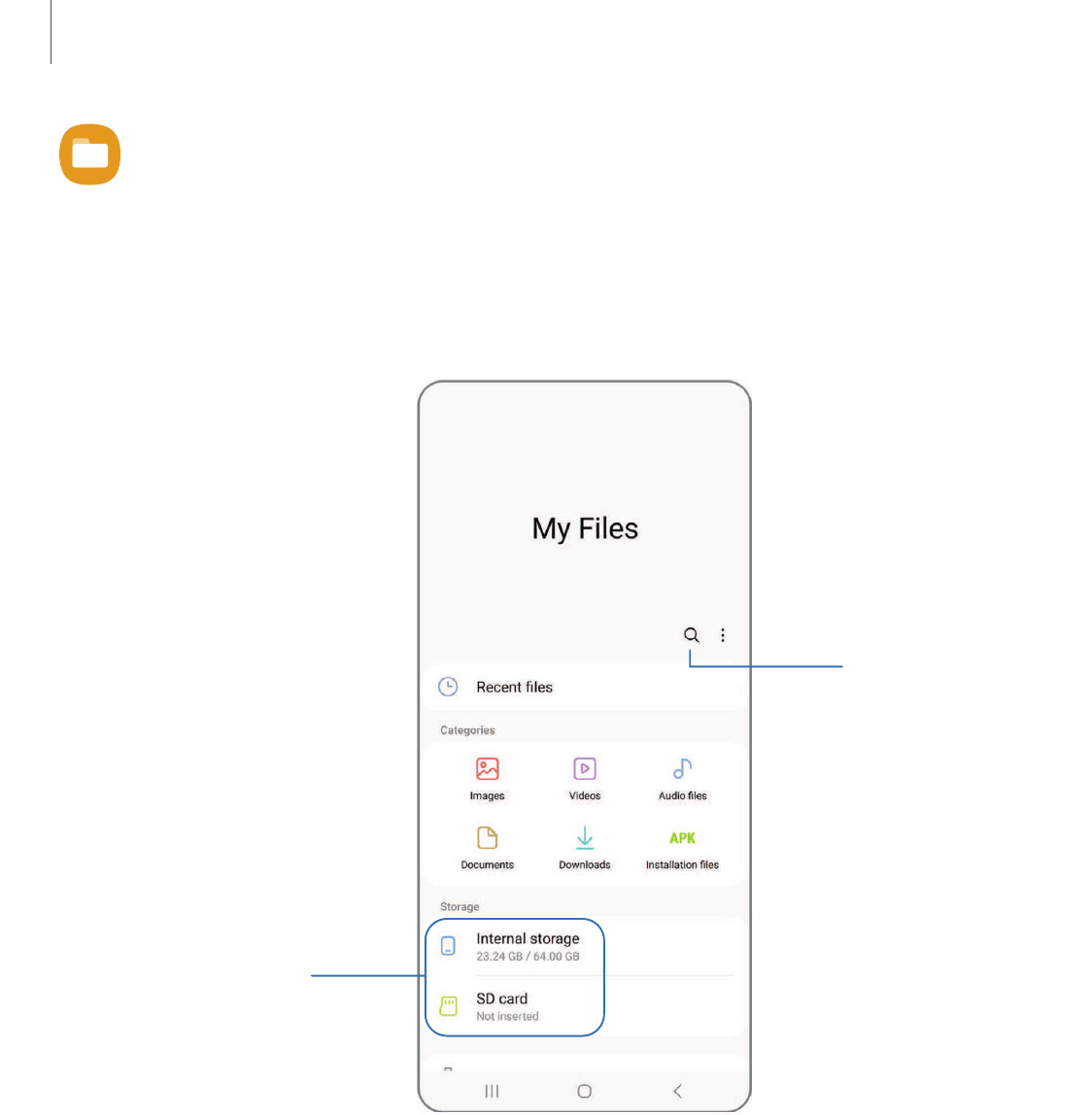
MyFiles
View and manage files stored on your device, including images, videos, music, and
sound clips. You can also access and manage files saved to your cloud accounts and
SD card, if supported.
Search
Storage locations
Additional
locations, such as
cloud accounts,
are displayed
here if supported.
Apps
71
Devices and software are constantly evolving — the illustrations you see here are for reference only.

File groups
Files stored in the device are organized into the following groups:
•
Recent files: View recently accessed files.
•
Categories: View your files based on the file type.
•
Storage: View files saved on your device, optional SDcard, and cloud accounts.
–
Cloud accounts vary depending on the services you sign into.
•
Analyze storage:See what’s taking up space in your storage.
My Files settings
Use My Files settings to customize your file management options and more. Options
may vary by service provider.
◌
From My Files, tap More options > Settings for thefollowing options:
•
Cloud accounts: Connect to and manage your cloud services.
•
File management: Customize how files are displayed, deleted, and access
mobile data.
•
Analyze storage: Choose a file size to flag when analyzing storage.
•
Privacy: View the permissions for My Files.
72
Apps
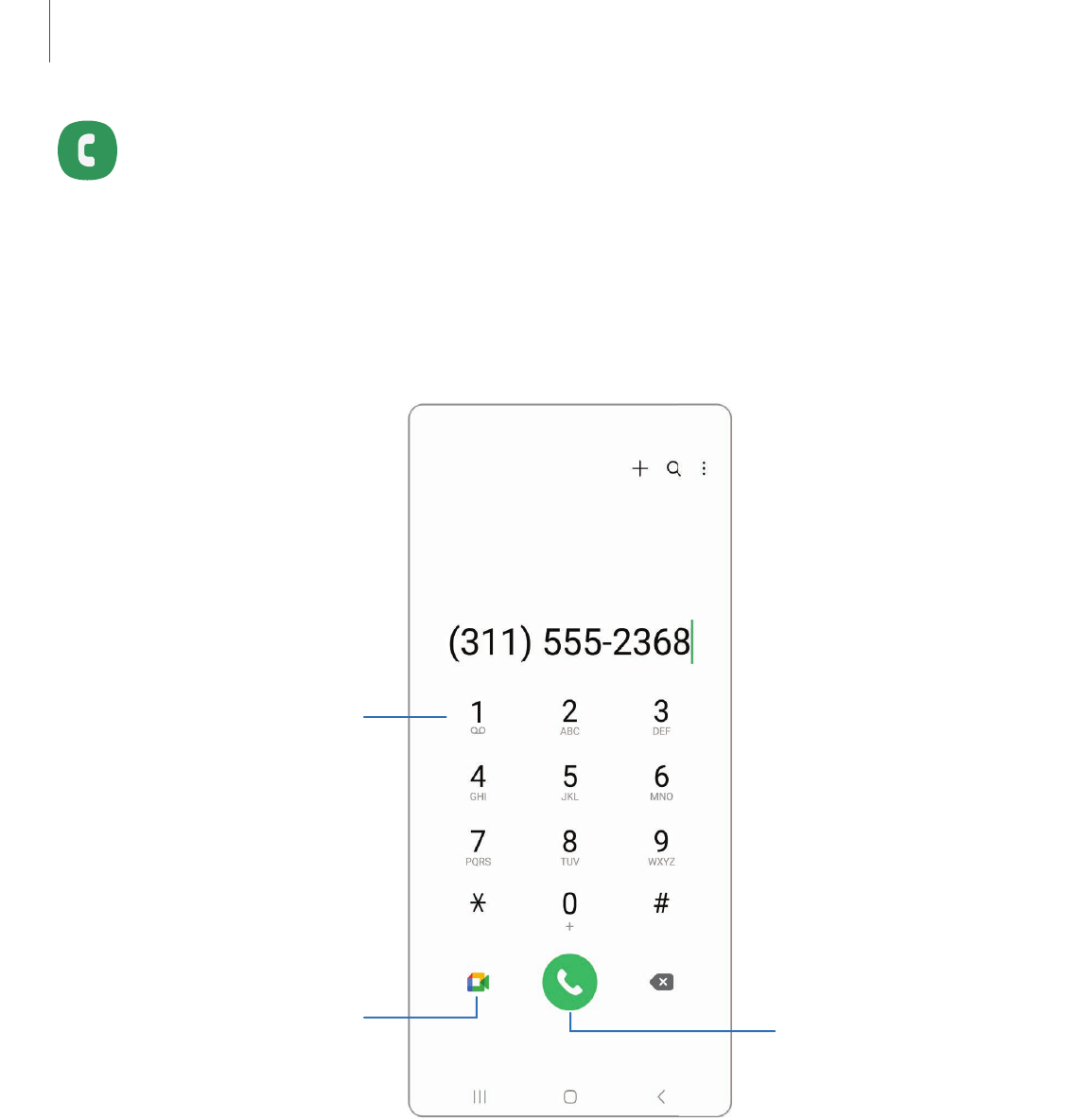
Phone
The Phone app does more than just make telephone calls. Explore the advanced
calling features. Contact your service provider for more information. The actual
appearance of the Phone app screen and available options varies by service
provider.
Access voicemail
Make a video call
Make a call
Apps
73
Devices and software are constantly evolving — the illustrations you see here are for reference only.

Calls
The Phone app allows you to make and answer calls from the Home screen, Recents
tab, Contacts and more.
Make a call
Use your phone to make and answer calls from a Home screen.
◌
From Phone, enter a number on the keypad and tap Call.
•
Tap Keypad if the keypad is not displayed.
Make a call from Recents
All incoming, outgoing, and missed calls are recorded in the Call log.
1.
From Phone, tap Recents to display a list of recent calls.
2.
Tap a contact, and then tap Call.
Make a call from Contacts
Call a contact from the Contacts app.
◌
From Contacts, swipe your finger across a contact to the right to call the
contact.
Answer a call
When a call is received, the phone rings and the caller’s phone number or name is
displayed. If you are using an app, a pop-up screen is displayed for the incoming call.
◌
On the incoming call screen, drag Answer to the right to answer the call.
TIPOn the incoming call pop-up screen, tap Answer to answer the call.
74
Apps

Decline a call
You can choose to decline an incoming call. If you are using an app, a pop-up screen is
displayed for the incoming call.
◌
On the incoming call screen, drag Decline to the left to reject the call and send
it to your voicemail.
TIPOn the incoming pop-up screen, tap Decline to reject the call and send it
to your voicemail.
Decline with a message
You can choose to decline an incoming call with a text message response.
◌
On the incoming call screen, drag Send message upward and select a message.
TIPOn the incoming call pop-up screen, tap Sendmessage and select a
message.
End a call
◌
Tap End call when you are ready to end your call.
Actions while on a call
You can adjust call volume, switch to a headset or speaker, and even multitask while
on a call.
◌
Press the Volume keys to increase or decrease the volume.
Switch to headset or speaker
Listen to the call using the speaker or through a Bluetooth
®
headset (not included).
◌
Tap Speaker to hear the caller using the speaker or tap Bluetooth to
hear the caller using a Bluetooth headset.
75
Apps

Multitask
If you exit the call screen to use another app, your active call is indicated in the Status
bar.
To return to the call screen:
◌
Drag the Status bar down to display the Notification panel and tap the call.
To end a call while multitasking:
◌
Drag the Status bar down to display the Notification panel, and then tap
End call.
Call background
Select a picture or video to show when you make or receive a call.
◌
From Phone, tap More options > Settings > Call background for the following
options:
•
Layout: Choose how to show caller info when the person has a profile picture.
•
Background: Choose a photo to display during a call.
Call pop-up settings
When calls are received while using other apps, they can be displayed as pop-ups.
◌
From Phone, tap More options > Settings > Call display while using apps. The
following options are available:
•
Full screen:Display an incoming call in the full screen Phone app.
•
Small pop-up: Display an incoming call as a pop-up at the top of the screen.
•
Mini pop-up: Display an incoming call as a smaller pop-up.
•
Keep calls in pop-up:Enable this option to keep calls in the pop-up after they
are answered .
76
Apps

Manage calls
Your calls are recorded in a call log. You can set up speed dials, block numbers, and
use voicemail.
Call log
The numbers of the calls you have dialed, received, or missed are stored in the Call
log.
◌
From Phone, tap Recents. A list of recent calls is displayed. Ifthe caller is in
your Contacts list, the caller’s name is displayed.
Save a contact from a recent call
Use recent call information to create a contact or update your Contacts list.
1.
From Phone, tap Recents.
2. Tap the call that contains the information that you want to save to your Contacts
list, and tap Add to contacts.
3. Tap Create new contact or Update existing contact.
Delete call records
To delete Call log entries:
1.
From Phone, tap Recents.
2. Touch and hold the call you want to delete from the Call log.
3.
Tap Delete.
Block a number
By adding a caller to your Block list, future calls from this number are sent directly to
your voicemail, and messages are not received.
1.
From Phone, tap Recents.
2.
Tap the caller you want to add to the Block list, and then tap Details.
3.
Tap Block, or More > Block contact and confirm when prompted.
TIPYou can also modify your Block list in Settings. From Phone, tap More
options> Settings > Block numbers.
77
Apps

Speed dial
You can assign a shortcut number to a contact for speed dialing their default number.
1.
From Phone, tap Keypad > More options > Speed dial numbers. The Speed
dial numbers screen displays the reserved speed dial numbers.
2. Tap an unassigned number.
•
Tap Menu to select a different Speed dial number than the next one in
sequence.
•
Number 1 is reserved for Voicemail.
3.
Type in a name or number, or tap Add from Contacts to assign a contact to
the number.
•
The selected contact is displayed in the Speed dial number box.
Make a call with Speed dial
You can make a call using Speed dial.
◌
From Phone, touch and hold the Speed dial number.
•
If the Speed dial number is more than one digit long, enter the first digits, and
then hold the last digit.
Remove a Speed dial number
You can remove an assigned Speed dial number.
1.
From Phone, tap More options > Speed dial numbers.
2.
Tap Delete by the contact you want to remove from Speed dial.
Emergency calls
You can dial the emergency telephone number in your region regardless of the
phone’s service status. If your phone is not activated, you can only make an
emergency call.
1.
From Phone, enter the emergency telephone number (911 in North America)
and tap Call.
2. Complete your call. During this type of call, you have access to most in-call
features.
78
Apps

TIP The emergency telephone number can be dialed even if the phone is locked,
allowing anyone to use your phone to call for help in an emergency. When
accessed from a locked screen, only the emergency calling feature is accessible
to the caller. The rest of the phone remains secured.
Phone settings
These settings allow you to modify settings associated with the Phone app.
◌
From Phone, tap More options > Settings.
Optional calling services
Your wireless service provider and service plan may support the following calling
services.
Place a multi-party call
Make another call while a call is in progress. Options may vary by service provider.
1.
From the active call, tap Add call to dial the second call.
2.
Dial the new number and tap Call. When the call is answered:
•
Tap Swap or the On hold number to switch between the two calls.
•
Tap Merge to hear both callers at once (multi-conferencing).
Video calls
To make Video calls:
◌
Tap Phone, enter a number, and then tap Meet or Video call or
Video call.
NOTENot all devices support video calling. Thereceiver has the option to accept
the video call or answer the call as a regular voice call.
79
Apps

Real Time Text (RTT)
Type back and forth in real time with the other person while on a call.
You can use RTT whenever you are calling someone whose phone also supports RTT
or is connected to a teletypewriter (TTY) device. The RTT icon appears on all incoming
RTTcalls.
1.
From Phone, tap More options > Settings.
2. Tap Real time text for the following options:
•
RTTcall button: Choose a visibility option for the RTTcall button.
•
Use external TTY keyboard:Hide the RTT keyboard when an external
TTYkeyboard is connected.
•
TTY mode:Choose the preferred TTY mode for the keyboard in use.
80
Apps
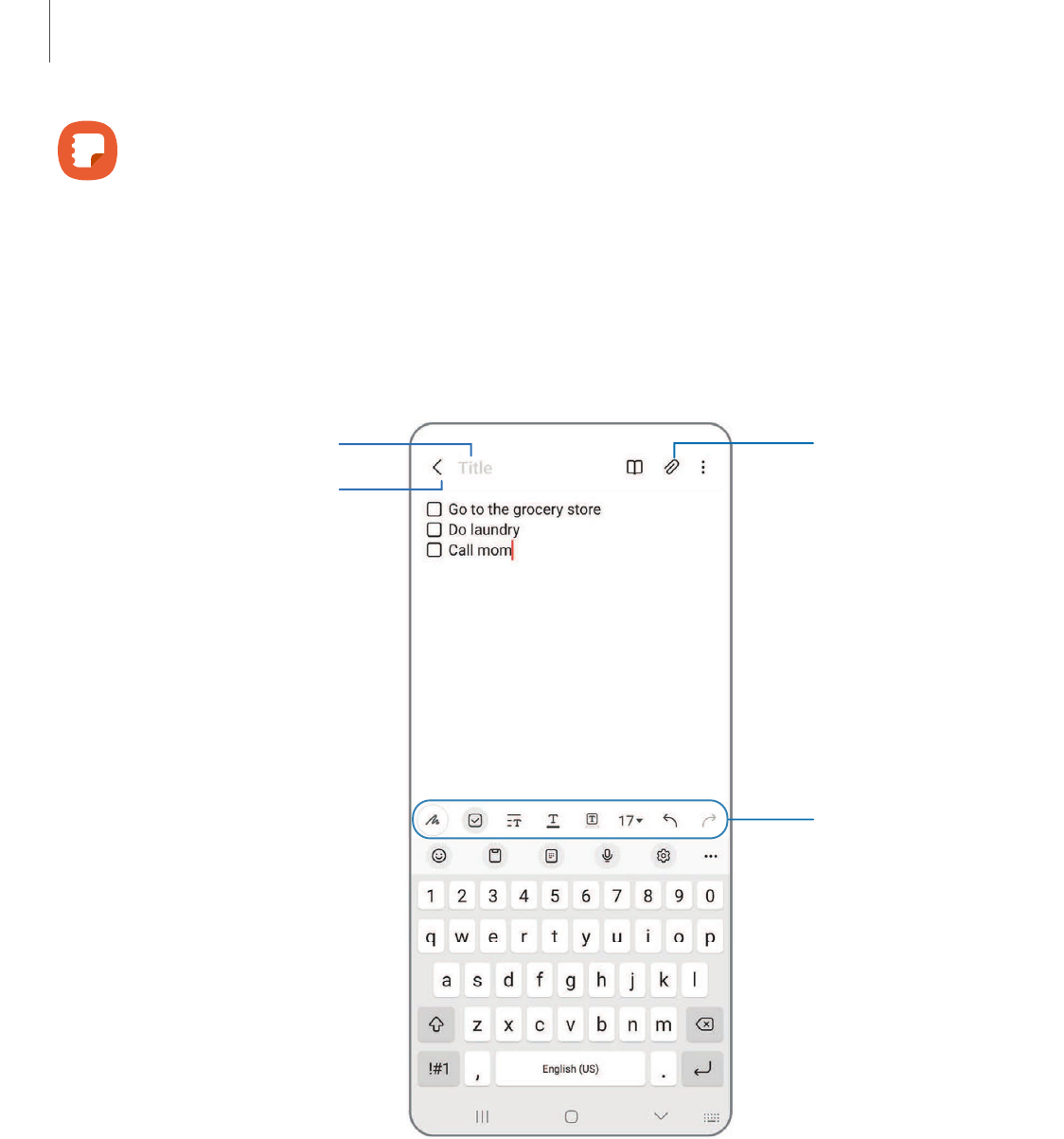
Samsung Notes
Use Samsung Notes to create notes containing text, images with footnotes, voice
recordings, and music. You can share your notes easily using social networking
services.
Visit samsung.com/us/support/owners/app/samsung-notes to learn more.
Set text options
Insert
Assign a title
Navigate up
Apps
81
Devices and software are constantly evolving — the illustrations you see here are for reference only.

Create notes
Add text, images, voice recordings and more.
1.
From Samsung Notes, tap Add.
2. Use the text options to create content.
Voice recordings
Create annotated voice recordings perfect for lectures or meetings. Take notes while
recording audio. Playback is synced to scroll to the corresponding text.
1.
From Samsung Notes, tap Add.
2.
Tap Insert > Voice recording.
3. Use the text options to create content while audio is being recorded.
Edit notes
Make edits to notes you create.
1.
From Samsung Notes, tap a note to view it.
2.
Tap Edit and make changes.
3.
When you are finished, tap Navigate up.
Notes options
You can edit, sort, or manage notes.
◌
From Samsung Notes, the following options are available:
•
Import PDF: Open a PDF in Samsung Notes.
•
Search: Search for a keyword.
•
More options:
–
Edit: Select notes to share, delete, save as file, lock, or move.
–
View: Switch between Grid, List, or Simple list.
–
Pin favorites to top: Keep notes marked as your favorites at the top of the
main page.
82
Apps

Notes menu
You can view your notes by category.
◌
From Samsung Notes, tap Show navigation menu for the following options:
•
Settings: View settings for the Samsung Notes app.
•
All notes: View all notes.
•
Shared notebooks:View notebooks shared with your contacts through your
Samsung account.
•
Trash: View deleted notes for up to 15 days.
•
Folders: View notes by groups.
•
Manage folders:Add, remove, and organize folders.
83
Apps

Google apps
The following Google apps may be preloaded on your device. Apps can be
downloaded from the Google Play
™
store.
Chrome| Drive| Gmail| Google| Google TV| Maps| Meet| Messages | Photos| Play
Store| YouTube| YT Music
Chrome
Browse the Internet with Chrome
™
and bring your open tabs, bookmarks, and address
bar data from your computer to your mobile device.
Visit support.google.com/chrome to learn more.
Drive
Open, view, rename, and share files saved to your Google Drive
™
cloudaccount.
Visit support.google.com/drive to learn more.
Gmail
Send and receive email with Google’s web-based email service.
Visit support.google.com/mail to learn more.
Google
Find online content with tools that learn what interests you. Turn on your personalized
feed to receive customized content.
Visit support.google.com/websearch to learn more.
84
Apps

Google TV
Watch movies and TV shows purchased from Google Play. You can also view videos
saved on your device.
Visit support.google.com/googletv to learn more.
Maps
Get directions and other location-based information. You must enable location
services to use Google Maps. For more information, see Location.
Visit support.google.com/maps to learn more.
Meet
Make cross-platform video calls on phones and tablets, smart devices, and on the
web.
Visit support.google.com/meet to learn more.
Messages
Send and receive messages over Wi-Fi or data with Google's official app for texting
and chat.
Visit support.google.com/messages to learn more.
Photos
Store and back up your photos and videos automatically to your Google Account with
Google Photos
™
.
Visit support.google.com/photos to learn more.
85
Apps

Play Store
Find new apps, movies and TV shows, music, books, magazines, and games in the
Google Play store.
Visit support.google.com/play to learn more.
YouTube
Watch and upload YouTube
™
videos right from your device.
Visit support.google.com/youtube to learn more.
YT Music
Stream and browse playlists, albums, and artists from YouTube Music.
86
Apps
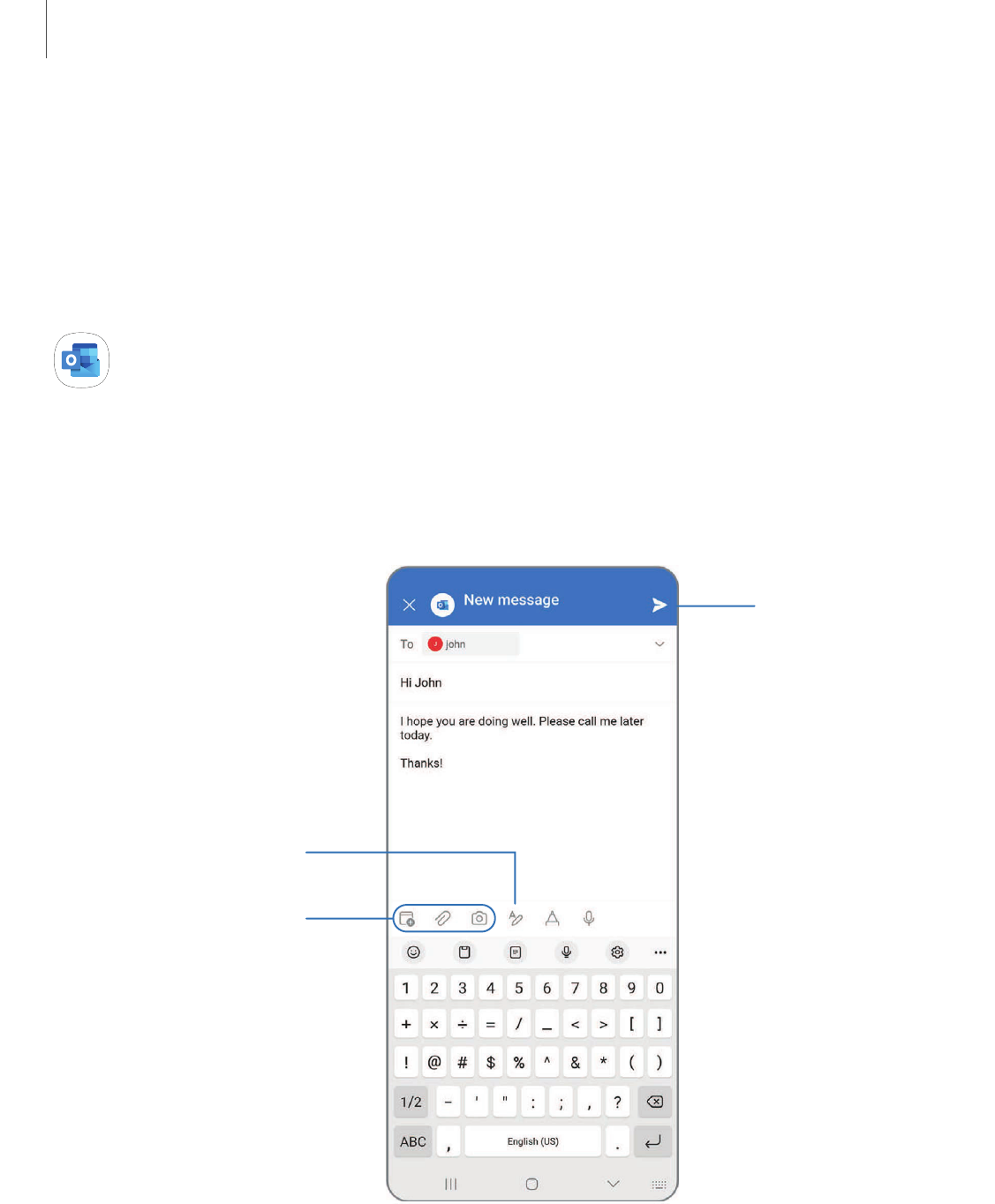
Microsoft apps
The following Microsoft apps may be preloaded on your device. Apps can be
downloaded from Galaxy Store and the Google Play store.
Outlook| Office | OneDrive
Outlook
Access email, calendar, contacts, tasks, and more in Outlook. See Add an Outlook
account. Visit support.office.com/en-us/article/outlook-for-ios-and-android-help-
cd84214e-a5ac-4e95-9ea3-e07f78d0cde6 to learn more.
Add attachment
Send message
Show formatting
options
Apps
87
Devices and software are constantly evolving — the illustrations you see here are for reference only.

Office
Enjoy the Word, Excel, and PowerPoint apps on your mobile device with the Microsoft
Office mobile app.
OneDrive
Store and share photos, videos, documents, and more in your free online OneDrive
®
account—accessible from your personal computer, tablet, or phone.
88
Apps

Access Settings
There are a couple of ways to access your device settings.
From a Home screen, swipe down and tap Settings.
From Apps, tap Settings.
Search for Settings
If you are not sure exactly where to find a certain setting, you can search for it.
1.
From Settings, tap Search, and enter keywords.
2. Tap an entry to go to that setting.
Connections
Manage connections between your device and a variety of networks and other
devices.
Wi-Fi| Bluetooth| NFC and payment| Airplane mode| Mobile networks| Data usage|
Mobile hotspot| Tethering| Nearby device scanning| Connect to a printer| Virtual
Private Networks| Private DNS| Ethernet
Wi-Fi
You can connect your device to a Wi-Fi network to access the Internet without using
your mobile data.
1.
From Settings, tap Connections > Wi-Fi, and then tap to turn on Wi-Fi and
scan for available networks.
2. Tap a network, and enter a password if required.
3. Tap Connect.
90
Settings

Connect to a hidden Wi-Fi network
If the Wi-Fi network you want is not listed after a scan, you can still connect to it by
entering the information manually. Ask the Wi-Fi network administrator for the name
and password before you begin.
1.
From Settings, tap Connections > Wi-Fi, and then tap to turn on Wi-Fi.
2.
Tap Add network at the bottom of the list.
3. Enter information about the Wi-Fi network:
•
Network name: Type the exact name of the network.
•
Security: Select a security option from the list, and enter the password if
required.
•
Password: Enter the network password.
•
Hidden network:Add a hidden network.
•
View more: Define other advanced options, such as IP and Proxy settings.
4. Tap Save.
TIP Tap Scan QRcode to connect to a Wi-Fi network by using your device’s
camera to scan a QR code.
Intelligent Wi-Fi settings
You can configure connections to various types of Wi-Fi networks and hotspots,
manage saved networks and look up your device's network addresses. Options may
vary by service provider.
1.
From Settings, tap Connections > Wi-Fi, and then tap to turn on Wi-Fi.
2.
Tap More options > Intelligent Wi-Fi for the following options:
•
Switch to mobile data: When enabled, your device will switch to mobile data
whenever the Wi-Fi connection is unstable. When the Wi-Fi signal is strong, it
switches back to Wi-Fi.
•
Turn Wi-Fi on/off automatically: Turn on Wi-Fi in frequently-used locations.
•
Auto Hotspot connection: Automatically connect to a Wi-Fi hotspot when
detected.
•
Intelligent Wi-Fi:View the Intelligent Wi-Fi version.
91
Settings

Advanced Wi-Fi settings
You can configure connections to various types of Wi-Fi networks and hotspots,
manage saved networks and look up your device's network addresses. Options may
vary by service provider.
1.
From Settings, tap Connections > Wi-Fi, and then tap to turn on Wi-Fi.
2.
Tap More options > Advanced settings for the following options:
•
Sync with Samsung Cloud/account:Sync Wi-Fi profiles with your Samsung
account.
•
Network notification /Wi-Fi notifications: Receive notifications when open
networks in range are detected.
•
Manage networks: View saved Wi-Fi networks and configure whether to auto
reconnect to or forget individual networks.
•
Wi-Fi on/off history: View apps that have recently turned your Wi-Fi on or off.
•
Hotspot 2.0: Connect automatically to Wi-Fi networks that support
Hotspot2.0.
•
Install network certificates: Install authentication certificates.
Wi-FiDirect
Wi-FiDirect uses Wi-Fi to share data between devices.
1.
From Settings, tap Connections > Wi-Fi, and then tap to turn on Wi-Fi.
2.
Tap More options > Wi-FiDirect.
3. Tap a device, and then follow the prompts to connect.
Disconnect from Wi-Fi Direct
Disconnect your device from a Wi-FiDirect device.
◌
From Settings, tap Connections > Wi-Fi > More options > Wi-FiDirect. Tap a
device to disconnect it.
92
Settings

Bluetooth
You can pair your device to other Bluetooth-enabled devices, like Bluetooth
headphones or a Bluetooth-enabled vehicle infotainment system. Once a pairing is
created, the devices remember each other and can exchange information without
having to enter the passkey again.
1.
From Settings, tap Connections > Bluetooth, and then tap to turn on
Bluetooth.
2. Tap a device and follow the prompts to connect.
TIPWhen sharing a file, tap Bluetooth to use this feature.
Rename a paired device
You can rename a paired device to make it easier to recognize.
1.
From Settings, tap Connections > Bluetooth, and then tap to turn on
Bluetooth.
2.
Tap Settings next to the device name, and then tap Rename.
3. Enter a new name, and tap Rename.
Unpair from a Bluetooth device
When you unpair from a Bluetooth device, the two devices no longer recognize each
other and you will need to pair with the device again in order to connect to it.
1.
From Settings, tap Connections > Bluetooth, and then tap to turn on
Bluetooth.
2.
Tap Settings next to the device, and then tap Unpair.
3. Tap Unpair to confirm.
93
Settings

Advanced options
Additional Bluetooth features are available in the Advanced menu. Options may vary
by service provider.
1.
From Settings, tap Connections > Bluetooth.
2.
Tap Advanced settings or More options > Advanced settings for the following
options:
l
Sync with Samsung Cloud/account:Sync files transferred through Bluetooth
with your Samsung account.
l
Ringtone sync: Use the ringtone set on your device when you receive calls
through a connected Bluetooth device.
l
Bluetooth control history: View apps that have used Bluetooth recently.
l
Block pairing requests:Add devices to block pairing requests.
l
Bluetooth scan history:View which apps have recently scanned for nearby
Bluetooth devices and manage Bluetooth features for apps.
NFC and payment
Near Field Communication (NFC) allows you to communicate with another device
without connecting to a network. This technology is used by Android Beam and
certain payment apps. The device that you are transferring to needs to support NFC,
and it needs to be within four centimeters of your device.
◌
From Settings, tap Connections > NFC and contactless payments, and then
tap to turn on this feature.
94
Settings

Tap and pay
Use an NFC payment app to make payments by touching your device to a compatible
credit card reader.
1.
From Settings, tap Connections > NFC and contactless payments, and then
tap to turn on NFC.
2. Tap Contactless payments to see the default payment app.
•
To use another payment app, tap an available app to choose it.
•
Touse a payment app that is open, tap Pay with currently open app.
•
To set another payment service as the default, tap Others, and then tap the
service you prefer.
Airplane mode
Airplane mode turns off all network connections including calling, texting, mobile data,
Wi-Fi, and Bluetooth. While Airplane mode is enabled, you can turn on Wi-Fi and
Bluetooth in Settings or from the Quick settings panel.
◌
From Settings, tap Connections > Airplane mode, and then tap to enable
this feature.
NOTEThe use of mobile devices on an aircraft or a ship may be subject to federal
and local guidelines and restrictions. Airplane mode will disable all network
connectivity. Ultra-wideband (UWB) is not permitted aboard aircraft or ships and
can be turned off by use of Airplane mode. Check with appropriate authorities
and always follow crew instructions regarding when and how you may use your
device.
Mobile networks
Use Mobile networks to configure your device's ability to connect to mobile networks
and use mobile data. Options may vary by service provider.
◌
From Settings, tap Connections > Mobile networks.
•
Mobile data: Enable mobile data usage.
•
International data roaming: Change voice, text and data roaming settings for
international roaming.
95
Settings

•
VoLTE calls: Turn on enhanced communication using LTE.
•
Access Point Names: Choose or add APNs, which have the network settings
your device needs to connect to your provider.
•
Network operators: Choose available and preferred networks.
•
Mobile network diagnostics: Collect diagnostic and usage data for
troubleshooting.
TIPUse these features to help manage connection settings that may affect your
monthly bill.
Data usage
Check your current mobile and Wi-Fi data usage. You can also customize warnings
and limits.
◌
From Settings, tap Connections > Data usage.
Turn on Data saver
Use Data saver to reduce your data consumption by preventing selected apps from
sending or receiving data in the background.
1.
From Settings, tap Connections > Data usage > Datasaver.
2.
Tap to turn on Data saver.
•
To allow some apps to have unrestricted data usage, tap Allowed to use data
while Data saver is on, and tap next to each app to specify restrictions.
Monitor mobile data
You can customize your mobile data access by setting limits and restrictions. Options
may vary by service provider.
◌
From Settings, tap Connections > Data usage. The following options are
available:
•
Mobile data: Use mobile data from your plan.
•
International data roaming: Enable mobile data services while roaming
internationally.
96
Settings

•
Mobile data usage: View data usage over mobile connections over a period
of time. You can view total usage as well as usage by app.
•
Billing cycle and data warning: Change the monthly date to align with your
service provider’s billing date.
TIPUse these features to keep an eye on your estimated data usage.
Monitor Wi-Fi data
You can restrict Wi-Fi data access by customizing usage limits and networks.
1.
From Settings, tap Connections > Data usage.
2. Tap Wi-Fi data usage to view data usage over Wi-Fi connections over a period of
time. You can view total usage as well as usage by app.
Mobile hotspot
Mobile hotspot uses your data plan to create a Wi-Fi network that can be used by
multiple devices.
1.
From Settings, tap Connections > Mobile hotspot and tethering>
Mobilehotspot.
2.
Tap to turn on Mobile hotspot.
3. On the devices you want to connect, activate Wi-Fi and select your device’s
Mobile hotspot. Enter the Mobile hotspot password to connect.
•
Connected devices are listed under the heading Connected devices.
TIPTap QR code to connect another device to your Mobile hotspot by
scanning a QR code instead of entering a password.
97
Settings

Configure mobile hotspot settings
You can customize your mobile hotspot's security and connection settings.
1.
From Settings, tap Connections > Mobile hotspot and tethering >
Mobilehotspot.
2. Tap Configure for the following settings:
•
Network name: View and change the name of your Mobile hotspot.
•
Password: If you choose a security level that uses a password, you can view
or change it.
•
Band: Select one of the available bandwidth options.
•
Security: Choose the security level for your Mobile hotspot.
•
Advanced:Configure additional Mobile hotspot settings.
Auto hotspot
Share your hotspot connection automatically with other devices signed in to your
Samsung account.
1.
From Settings, tap Connections > Mobile hotspot and tethering > Mobile
hotspot.
2.
Tap Auto hotspot, and tap to enable the feature.
Tethering
You can use tethering to share your device’s Internet connection with another device.
Options may vary by service provider.
1.
From Settings, tap Connections > Mobile hotspot and tethering.
2. Tap an option:
•
Tap Bluetooth tethering to share your device’s Internet connection using
Bluetooth.
•
Connect the computer to the device using a USBcable, and then tap
USB tethering.
•
Connect the computer to the device using an Ethernet adapter, and
then tap Ethernet tethering.
98
Settings

Nearby device scanning
Easily set up connections to other available devices by turning on Nearby device
scanning. This feature sends you a notification when there are available devices to
connect to.
1.
From Settings, tap Connections > More connection settings > Nearby device
scanning.
2.
Tap to turn on the feature.
Connect to a printer
Connect your device to a printer on the same Wi-Fi network to easily print documents
and images from your device.
1.
From Settings, tap Connections > More connection settings > Printing.
2.
Tap Default print service, and then tap More options > Add printer.
•
If your printer requires a plugin, tap Download plugin and follow the
prompts to add a print service.
NOTENot all apps support printing.
Virtual Private Networks
A Virtual Private Network (VPN) allows you to connect to a private secured network
from your device. You will need the connection information from your VPN
administrator.
1.
From Settings, tap Connections > More connection settings > VPN.
2.
Tap More options > Add VPN profile.
3. Enter the VPN network information provided by your network administrator, and
tap Save.
99
Settings

Manage a VPN
Use the VPN settings menu to edit or delete a VPN connection.
1.
From Settings, tap Connections > More connection settings > VPN.
2.
Tap Settings next to a VPN.
3. Edit the VPN and tap Save, or tap Delete to remove the VPN.
Connect to aVPN
Once you have set up a VPN, connecting to and disconnecting from a VPN is easy.
1.
From Settings, tap Connections > More connection settings > VPN.
2. Tap a VPN, enter your log in information, and tap Connect.
l
To disconnect, tap the VPN, and then tap Disconnect.
Private DNS
You can configure your device to connect to a private DNShost.
1.
From Settings, tap Connections > More connection settings > Private DNS.
2. Tap one of the available options to configure a private DNS connection.
3. Tap Save.
Ethernet
If wireless network connection is not available, you can use an Ethernet cable to
connect your device to a local network.
1. Connect an Ethernet cable to your device.
2.
From Settings, tap Connections > More connection settings > Ethernet, and
follow the prompts.
TIP You need an adapter (not included) to connect an Ethernet cable to your
device.
100
Settings

Sounds and vibration
You can control the sounds and vibrations used to indicate notifications, screen
touches, and other interactions.
Sound mode| Vibrations| Volume| Ringtone| Notification sound| System sound| Dolby
Atmos| Separate app sound
Sound mode
You can change the sound mode on your device without using the volume keys.
◌
From Settings, tap Sounds and vibration, and then choose a mode:
•
Sound: Use the sounds, vibrations, and volume levels you have chosen in
Sound settings for notifications and alerts.
–
Vibrate while ringing:Set your device to vibrate in addition to ringing when
you receive a call.
•
Vibrate: Use vibration only for notifications andalerts.
•
Mute: Set your device to make no sounds.
–
Temporary mute: Set a time limit for muting the device.
TIPUse the sound mode setting instead of the volume keys to change the sound
mode without losing your customized sound levels.
101
Settings

Vibrations
You can control how and when your device vibrates.
1.
From Settings, tap Sounds and vibration.
2. Tap options to customize:
•
Call vibration: Choose from preset vibration patterns for calls.
•
Notification vibration: Choose from preset vibration patterns for notifications.
•
System vibration: Configure vibration intensity and feedback for the following
options:
–
System vibration intensity: Drag the slider to adjust vibration intensity.
–
Touch interactions:Vibrate when you tap navigation buttons or touch
and hold items on the screen.
–
Dialing keypad: Vibrate when dialing numbers on the Phone keypad.
–
Samsung keyboard: Vibrate when typing with the Samsung
keyboard.
–
Charging: Vibrate when a charger is connected.
–
Navigation gestures: Vibrate when using gestures.
•
Vibrationintensity: Set vibration intensity levels for calls, notifications, and
touch interactions by dragging the sliders.
Volume
Set the volume level for call ringtones, notifications, media, and system sounds.
◌
From Settings, tap Sounds and vibration > Volume, and drag the sliders for
each sound type.
TIP You can also use the Volume keys to adjust the volume. When pressed, a
pop-up menu shows the volume level and current sound type. You can tap the
menu to expand it, and then adjust the volume of the other sound types by
dragging their sliders.
102
Settings

Use Volume keys for media
Set the default action of the Volume keys to control the media sound volume rather
than whichever sound type is in use.
1.
From Settings, tap Sounds and vibration > Volume.
2. Tap Use Volume keys for media to enable this feature.
Media volume limit
Limit the maximum output of the device’s volume while using Bluetooth speakers or
headphones (notincluded).
1.
From Settings, tap Sounds and vibration > Volume.
2.
Tap More options > Media volume limit.
3.
Tap to enable this feature.
l
To set the maximum output volume, drag the Custom volume limit slider.
l
To require a PIN to make changes to the volume setting, tap Set volume
limitPIN.
Ringtone
Customize your call ringtone by choosing from preset sounds or adding your own.
Options may vary by service provider.
1.
From Settings, tap Sounds and vibration > Ringtone.
2.
Tap a ringtone to hear a preview and select it, or tap Add to use an audio file
as a ringtone.
Notification sound
Choose a preset sound for all notification alerts.
1.
From Settings, tap Sounds and vibration > Notification sound.
2. Tap a sound to hear a preview and select it.
TIPYou can also customize notifications sounds to be unique for each app using
the App settings menu.
103
Settings

System sound
Customize your device's sounds for actions like tapping the screen and charging the
device. Options may vary by service provider.
◌
From Settings, tap Sounds and vibration >System sound for the following
options:
•
System sound volume:Drag the slider to adjust the system volume.
•
Touch interactions: Play tones when you touch or tap the screen to make
selections.
•
Dialing keypad: Play a tone when dialing numbers on the Phone keypad.
•
Samsung keyboard: Play a sound when typing with the Samsung keyboard.
•
Charging: Play a sound when a charger is connected.
•
Screen lock/unlock: Play a sound when you lock or unlock the screen.
Dolby Atmos
Enjoy Dolby Atmos quality when playing content that was specifically mixed for
Atmos. This feature may only be available with a headset connected.
◌
From Settings, tap Sounds and vibration > Sound qualityand effects for the
following options:
•
Dolby Atmos: Experience breakthrough audio that flows above and around
you.
•
Dolby Atmos for gaming:Apply Dolby Atmos optimized for gaming.
104
Settings

Separate app sound
You can choose to have an app play only media sound on a Bluetooth speaker or
headset separate from the other sounds (like notifications). Connect to a Bluetooth
device to make this option available in the Audio device menu.
1.
From Settings, tap Sounds and vibration > Separate app sound.
2. Tap Turn on now to enable Separate app sound, and then set the following
options:
•
App: Choose an app to play its sound on a separate audio device.
•
Audio device: Choose the audio device that you want the app’s sound to be
played on.
Notifications
You can prioritize and streamline app alerts by changing which apps send
notifications and how notifications alert you.
App notifications | Lock screen notifications | Notification pop-up style | Do not disturb|
Advanced settings | Turn over to mute
App notifications
Choose which apps are allowed to send you notifications.
◌
From Settings, tap Notifications >App notifications, and then tap to enable
notifications for individual apps.
Lock screen notifications
Choose which notifications are allowed on the Lock screen.
◌
From Settings, tap Notifications >Lock screen notifications, and then tap to
enable the feature. Tap an option to customize:
•
Hide content: Do not show notifications in the Notification panel.
•
Notifications to show:Choose which notifications to show on the Lock screen.
105
Settings

Notification pop-up style
You can change the style and additional settings for your notifications.
◌
From Settings, tap Notifications >Notification pop-up style, and then choose a
pop-up style:
•
Brief: Enable customization of your notifications.
–
Apps to show as brief: Choose apps to show as brief notifications.
–
Edge lighting style: Choose a style of edge lighting for notifications.
–
Color by keyword: Choose custom colors for notifications containing
keywords that matter to you.
•
Detailed: Enable the default Samsung Notification settings.
Do not disturb
Do not disturb allows you to block sounds and notifications while this mode in turned
on. You can also specify exceptions for people, apps, and alarms. You can also set a
schedule for recurring events like sleep or meetings.
◌
From Settings, tap Notifications > Donotdisturb and configure thefollowing:
•
Do not disturb: Enable Do not disturb to block sounds and notifications.
•
For how long?: Choose a default duration for Do not disturb mode when you
enable it manually.
Schedule
•
Sleeping: Customize a schedule for Do not disturb mode while you are
sleeping.
•
Add schedule: Create a new schedule to configure the days and times to
regularly put your device in Do not disturb mode.
Allowed during Do not disturb
•
Calls and messages: Tap to allow Do not disturb exceptions.
•
App notifications: Add apps that you would like to receive notifications from in
Do not disturb mode. Call, message, and conversation notifications will still
reach you even if you don’t allow the associated apps.
106
Settings

•
Alarms and sounds: Enable sounds and vibrations for alarms, events, and
reminders while Do not disturb mode is active.
•
Hide notifications: View customization options to hide notifications.
Advanced settings
You can configure notifications from apps and services.
◌
From Settings, tap Notifications > Advanced settings.
•
Show notification icons: Modify how many notifications appear on the
Statusbar.
•
Show battery percentage: Display the current battery life of your device on
the Status bar.
•
Notification history: Display recent and snoozed notifications.
•
Conversations: View conversation notifications. Touch and hold a
conversation notification to mark it as priority, set it as alerting, or silent.
•
Floating notifications: Enable floating notifications in either Bubbles or Smart
pop-up view.
•
Suggest actions and replies for notifications: Get applicable suggestions for
actions to notifications and replies to messages.
•
Show snooze button: Enable to display a button to quickly snooze your
notifications.
•
Notification reminders: Enable and customize periodic reminders about
notifications from selected apps and services. Clear notifications to stop the
reminders.
107
Settings

•
App icon badges: Identify which apps have active notifications with badges
that appear on their icons. Tap to choose whether or not badges indicate the
number of unread notifications.
•
Wireless Emergency Alerts: Customize notifications for emergency alerts.
Turn over to mute
Mute incoming calls and alarms by turning your phone face down.
◌
From Settings, tap Advanced features> Motions and gestures >Turn over to
mute, and tap to enable.
Display
You can configure the screen brightness, timeout delay, font size, and many other
display settings.
Dark mode| Screen brightness| Motion smoothness| Eye comfort shield|Font size and
style| Screen zoom| Full screen apps| Camera cutout | Screen timeout | Accidental
touch protection| Touch sensitivity| Screen saver| Double tap to turn on screen|
Double tap to turn off screen| One-handed mode
Dark mode
Dark mode allows you to switch to a darker theme to keep your eyes more
comfortable at night, darkening white or bright screens and notifications.
◌
From Settings, tap Display for the following options:
l
Light: Apply a light color theme to your device (default).
l
Dark: Apply a dark color theme to your device.
l
Dark mode settings: Customize when and where Dark mode is applied.
–
Turn on as scheduled: Configure Dark mode for either Sunset to sunrise or
Custom schedule.
108
Settings

Screen brightness
Adjust the screen brightness according to lighting conditions or personal preference.
1.
From Settings, tap Display.
2. Customize options under Brightness:
•
Drag the Brightness slider to set a custom brightness level.
•
Tap Adaptive brightness to automatically adjust the screen brightness based
on the lighting conditions.
TIP You can also adjust screen brightness from the Quick settings panel.
Motion smoothness
Get smoother scrolling and more realistic animations by increasing the screen’s
refresh rate.
1.
From Settings, tap Display > Motion smoothness.
2. Tap an option, and then tap Apply.
Eye comfort shield
This feature may help you sleep better and reduce eye strain. You can set a schedule
to automatically turn this feature on and off.
◌
From Settings, tap Display > Eye comfort shield, and then choose one of the
following options:
•
Tap to enable this feature.
•
Tap Set schedule and choose Always on, Sunset to sunrise, or Custom.
•
Drag the Color temperature slider to set the opacity of the filter.
109
Settings

Font size and style
You can change the font size and style to customize your device.
◌
From Settings, tap Display > Font size and style for the following options:
•
Tap Font style to choose a different font.
–
Tap a font to select it, or tap Download fonts to add fonts from
Galaxy Store.
•
Tap Bold font to make all fonts appear with bold weight.
•
Drag the Font size slider to adjust the size oftext.
Screen zoom
Adjust the zoom level to make content easier to see.
1.
From Settings, tap Display > Screen zoom.
2. Drag the Screen zoom slider to adjust the zoom level.
Full screen apps
You can choose which apps you want to use in the full screen aspect ratio.
◌
From Settings, tap Display > Full screen apps and tap apps to enable this
feature and customize options.
Camera cutout
You can hide the camera cutout area with a black bar.
◌
From Settings, tap Display > Camera cutout and tap apps to enable this
feature and customize options.
Screen timeout
You can set the screen to turn off after a set amount of time.
◌
From Settings, tap Display >Screen timeout, and tap a time limit to set it.
NOTEProlonged display of non-moving images, excluding Always On Display,
may result in permanent ghost-like afterimages or degraded image quality. Turn
off the display screen when not in use.
110
Settings

Accidental touch protection
Prevent the screen from detecting touch input while the device is in a dark place, such
as a pocket or a bag.
◌
From Settings, tap Display > Accidental touch protection to enable the feature.
Touch sensitivity
Increase the touch sensitivity of the screen for use with screen protectors.
◌
From Settings, tap Display > Touchsensitivity to enable.
Screen saver
You can display colors or photos when the screen turns off or while charging.
1.
From Settings, tap Display > Screen saver.
2. Choose one of the following options:
•
None:Do not display a screen saver.
•
Colors: Tap the selector to display a changing screen of colors.
•
Photo table: Display pictures in a photo table.
•
Photo frame: Display pictures in a photo frame.
•
Photos: Display pictures from your Google Photos account.
3. Tap Preview for a demonstration of the selected Screen saver.
TIPTap Settings next to a feature for additional options.
Double tap to turn on screen
Turn on the screen by double-tapping instead of using the Side key.
◌
From Settings, tap Advanced features > Motions and gestures > Double tap
to turn on screen to enable this feature.
111
Settings

Double tap to turn off screen
Turn off the screen by double-tapping instead of using the Side key.
◌
From Settings, tap Advanced features > Motions and gestures > Double tap
to turn off screen to enable this feature.
One-handed mode
You can change the screen layout to accommodate operating your device with one
hand.
1.
From Settings, tap Advanced features > One-handed mode.
2.
Tap to enable the feature and select one of the following options:
•
Gesture: Swipe down in the center of the bottom edge of the screen.
•
Button: Tap Home two times in quick succession to reduce the display size.
Lock screen and security
You can secure your device and protect your data by setting a screen lock.
Screen lock types| Google Play Protect| Security update| Find My Mobile| Private
Share| Install unknown apps| Encrypt SD card| Password for factory data reset| Set
up SIM card lock| View passwords| Device administration| Credential storage|
Advanced security settings | Permission manager| Controls and alerts | Samsung
Privacy| Google Privacy | Location
Screen lock types
You can choose from the following screen lock types that offer high, medium, or no
security: Swipe, Pattern, PIN, Password, and None.
NOTEBiometric locks are also available to protect access to your device and
sensitive data on your device. For more information, see Biometric security.
112
Settings

Set a secure screen lock
It is recommended that you secure your device using a secure screen lock (Pattern,
PIN, or Password). This is necessary to set up and enable biometric locks.
1.
From Settings, tap Lock screen > Screen lock type and tap a secure screen
lock (Pattern, PIN, or Password).
2.
Tap to enable showing notifications on the lock screen. The following
options are available:
•
Hide content: Do not show notifications in the Notification panel.
•
Notifications to show:Choose which notifications to show on the Lock screen.
3. Tap Done to exit the menu.
4. Configure the following screen lock options:
•
Smart Lock: Unlock your device automatically when trusted locations or
other devices have been detected. Asecure screen lock is required for this
feature.
•
Secure lock settings: Customize your secure lock settings. A secure screen
lock is required for this feature.
•
Lock screen:Tap to edit the items on and appearance of the Lock screen.
•
Widgets:Tap to edit the widgets that appear with the clock on the Lock
screen.
•
Touch and hold to edit:Choose whether to allow items on the Lock screen to
be edited by touching and holding them.
•
Roaming clock: Show the time both where you are and at home while you
are roaming.
•
About Lock screen: Update the Lockscreen’s software.
Google Play Protect
You can configure Google Play to regularly check your apps and device for security
risks and threats.
◌
From Settings, tap Security and privacy > App security > Google Play Protect.
•
Updates are checked for automatically.
113
Settings

Security update
You can easily check the date of the last installed security software update and find
out if newer updates are available.
◌
From Settings, tap Security and privacy > Updates > Security update to see the
latest security update installed and check if a newer update is available.
Find My Mobile
You can protect your device from loss or theft by allowing your device to be locked,
tracked online, and for your data to be deleted remotely. A Samsung account is
required, and Google location service must be turned on in order to use Find My
Mobile. For more information, visit samsung.com/us/support/owners/app/find-my-
mobile.
Turn on Find My Mobile
Before you can use the Find My Mobile feature, you must turn it on and customize
the options. To access your device remotely, visit findmymobile.samsung.com.
1.
From Settings, tap Security and privacy > FindMy Mobile.
2.
Tap to enable Find My Mobile and log in to your Samsung account. The
following options are available:
•
Remote unlock: Allow Samsung to store your PIN, pattern, or password,
allowing you to unlock and control your device remotely.
•
Send last location: Allow your device to send its last location to the Find My
Mobile server when the remaining battery charge falls below a certain level.
Private Share
Share files privately, prevent recipients from resharing, and set expiration dates. Keep
your data safe with blockchain technology.
◌
From Settings, tap Security and privacy > Private share, and follow the
prompts to add files.
114
Settings

Install unknown apps
You can allow installation of unknown third-party apps from selected apps or
sources.
1.
From Settings, tap Security and privacy > Install unknown apps.
2.
Tap to allow installation from an app or source.
TIPInstalling unknown third-party apps could make your device and personal
data more vulnerable to security risks.
Encrypt SD card
You can encrypt your optional microSD card (not included) to protect its data. This
only allows the card information to be accessed from your device with a password.
1.
From Settings, tap Security and privacy > Other security settings > Encrypt SD
card.
2. Tap Encrypt SD card and follow the prompts to encrypt all data on your microSD
card.
NOTEPerforming a Factory data reset on your device prevents it from accessing
an encrypted microSD card. Before initiating a Factory data reset, make sure to
decrypt the installed microSD card first.
Password for factory data reset
You can require a password to reset your device to factory default settings. Options
may vary by service provider.
◌
From Settings, tap Security and privacy > Othersecurity settings >
Setup/change password and enter a password.
115
Settings

Set up SIM card lock
You can set up a PIN to lock your SIMcard, which prevents unauthorized use of your
SIM card if someone attempts to use it in another device. Options may vary by service
provider.
◌
From Settings, tap Security and privacy > Other security settings > Set up SIM
card lock and follow the prompts.
•
Tap Lock SIM card to turn on the feature.
•
Tap Change SIM card PIN to create a new PIN.
View passwords
You can have characters displayed briefly in password fields as you type them.
◌
From Settings, tap Security and privacy > Other security settings > Make
passwords visible to turn on the feature.
Device administration
You can authorize security features and apps to have administrative access to your
device.
1.
From Settings, tap Security and privacy > Other security settings > Device
admin apps.
2. Tap an option to turn it on as a device administrator.
Credential storage
You can manage the trusted security certificates installed on your device, which
verify the identity of servers for secure connections.
◌
From Settings, tap Security and privacy > Other security settings for the
following options:
•
View security certificates: Display the certificates on your device.
•
User certificates: View user certificates that identify your device.
•
Install from device/phone storage: Install a new certificate from storage.
116
Settings

•
Clear credentials: Erase credential contents from the device and reset the
password.
•
Certificate management app: Select a certification management app for
credential contents.
Advanced security settings
You can use these options to configure advanced security settings to better protect
your device.
◌
From Settings, tap Security and privacy > Other security settings for the
following options:
•
Trust agents: Allow trusted devices to perform selected actions when
connected.
–
This option is only displayed when a lock screen is turned on. For more
information, see Set a secure screen lock.
•
Pin windows: Pin an app on your device screen, which prevents access to
other features of your device.
•
Galaxy system app update:Configure your device to receive and install
Samsung updates automatically.
•
Security policy updates: Keep your device secure by checking for security
updates.
Permission manager
Apps might access features of your device that you permit them to (like the camera,
microphone, or location) when they are running in the background, not just when you
are using the app. You can set your device to notify you when this happens.
1.
From Settings, tap Security and privacy > Privacy > Permission manager.
2. Tap a category, then tap an app to select which permissions you want to be
notified about.
NOTEWhen using an app or service for the first time that wants to access certain
features of your device, a dialog box asks if you want to permit such access.
117
Settings

Controls and alerts
Control app access to the camera, microphone, and clipboard..
1.
From Settings, tap Security and privacy > Privacy.
2. Under Controls and alerts tap the following options to enable or disable:
•
Microphone access: Allow apps to use the microphone if they have the
appropriate permissions.
•
Alert when clipboard accessed: Get an alert when an app accesses content
copied to the clipboard.
Samsung Privacy
Send diagnostic information about your device to Samsung when you are having
technical problems.
1.
From Settings, tap Security and privacy > Privacy > Other privacy settings.
2. Under Samsung tap the following options to customize:
•
Samsung Privacy: View Samsung's privacy information.
•
Customization Service: Allow Samsung to provide customized content and
recommendations.
•
Send diagnostic data: Send diagnostic information about your device to
Samsung when you are having technical problems.
Google Privacy
Customize Android and Google privacy features.
1.
From Settings, tap Security and privacy > Privacy > Other privacy settings.
2. Under Google tap privacy services to customize them.
118
Settings

Location
Location services use a combination of GPS, mobile network and Wi-Fi to determine
the location of your device.
1.
From Settings, tap Location.
2.
Tap to turn on Location services.
TIPSome apps require location services be turned on for full functionality.
App permissions
Configure permissions for apps that want to access your location information.
1.
From Settings, tap Location > App permissions.
2. Tap an app and chose which location permissions to grant it. Options vary by
app.
Location services
Location services store and use your device’s most recent location data. Certain apps
can use this data to improve your search results based on places that you have
visited.
1.
From Settings, tap Location.
2. Tap an entry under Location services to see how your location information is
used.
Recent access
View a list of apps that have requested your location.
1.
From Settings, tap Location.
2.
Tap to turn on Location services.
3. Tap an entry under Recent access to view the app’s settings.
119
Settings

Emergency Location Service
If Emergency Location Service (ELS) is supported in your region, when you call or text
an emergency number, your device can automatically send its location to
emergency response partners.
1.
From Settings, tap Safety and emergency > Emergency Location Service.
2.
Tap to turn on Emergency Location Service.
Accounts
You can connect to and manage your accounts, including your Google Account,
Samsung account, email, and social networking accounts.
Add an account| Account settings| Remove an account| Backup and restore| Google
settings
Add an account
You can add and sync all your email, social networking, and picture and video sharing
accounts.
1.
From Settings, tap Accounts and backup > Manage accounts> Add
account.
2. Tap one of the account types.
3. Follow the prompts to enter your credentials and set up the account.
l
Tap Auto sync data to enable automatic updates to your accounts.
Account settings
Each account has its own custom settings. You can configure common settings for all
accounts of the same type. Account settings and available features vary between
account types.
1.
From Settings, tap Accounts and backup > Manage accounts.
2. Tap an account to customize its settings.
120
Settings

Remove an account
You can remove accounts from your device.
1.
From Settings, tap Accounts and backup > Manage accounts.
2. Tap the account and then tap Remove account.
Backup and restore
You can configure your device to back up data to your personal accounts.
Samsung account
You can enable backup of your information to your Samsung account. Options may
vary by service provider.
◌
From Settings, tap Accounts and backup and tap an option under Samsung
Cloud:
•
Back up data: Configure your Samsung account to back up your data.
•
Restore data: Use your Samsung account to restore your backup data.
Google Account
You can enable backup of your information to your Google Account.
1.
From Settings, tap Accounts and backup.
2. UnderGoogle Drive, tap Back updata.
External storage transfer
You can back up your data to an SDcard or a USBstorage device, or restore backup
data using Smart Switch. For more information, see Bring data from an old device.
◌
From Settings, tap Accounts and backup > External storage transfer.
Google settings
You can configure your device’s Google settings. Available options depend on your
Google Account.
◌
From Settings, tap Google, and select an option to customize.
121
Settings

Device maintenance
View the status of your device’s battery, storage, and memory. You can also
automatically optimize your device’s system resources.
Quick optimization | Battery| Storage| Memory| Advanced device care options|
Language and input| Date and time| Troubleshooting
Quick optimization
The quick optimization feature improves device performance through the following
actions:
•
Identifying apps that use excessive battery power and clearing unneeded items
from memory.
•
Deleting unnecessary files and closing apps running in the background.
•
Scanning for malware.
To use the quick optimization feature:
◌
From Settings, tap Battery and device care > Optimize now.
Battery
View how battery power is used for your various device activities.
◌
From Settings, tap Battery and device care > Battery for the following options:
•
Power saving: Save battery life by limiting background network usage,
syncing, and location checking. Choose from additional power saving
options to save more power when this mode is enabled.
•
Background usage limits: View apps that you don’t use often and limit their
battery usage. To disable this feature, tap Put unused apps to sleep.
•
Usage since last full charge: View your recent battery usage by time, app,
and service.
•
More battery settings: Configure additional battery settings and notifications.
122
Settings

Storage
View your storage capacity and detailed usage by category and file type. You can
also mount, unmount, or format an optional microSD card (not included).
◌
From Settings, tap Battery and device care > Storage.
•
Tap a category to view and manage files.
SD card
Once an optional microSD card (not included) has been installed in your device, the
card is displayed in the Storage setting.
For more information, see Set up your device.
Mount an SD card
When you install an optional microSD card, it is automatically mounted (connected to
the device) and prepared for use. However, should you unmount the card without
removing it from the device, you need to mount it before it can be accessed.
1.
From Settings, tap Battery and device care > Storage.
2. Swipe the screen to SDcard, and then tap Mount.
Remove an SD card
To prevent damage to information stored on the card, unmount the card before
removing it from the device.
1.
From Settings, tap Battery and device care > Storage.
2.
Swipe the screen to SDcard, and then tap More options > Unmount.
3. Remove your microSD card from the device.
123
Settings

Format an SD card
When formatting an SD card, you should back up all files that are stored on the card
because formatting the SD card deletes ALL stored files.
1.
From Settings, tap Battery and device care > Storage.
2.
Swipe the screen to SDcard, and then tap More options > Format.
3. Tap Format to confirm.
Memory
Check the amount of available memory. You can close background apps and reduce
the amount of memory you are using to speed up your device.
◌
From Settings, tap Battery and device care > Memory. The used and available
memory are shown.
•
Tap Clean now to free up as much memory as possible.
•
Tap View more to view the full list of apps and services using memory.
Tap to include or exclude these apps and services.
•
Tap Apps not used recently to view apps and services that are included in this
group. Tap to include or exclude these apps and services.
•
Tap Excluded apps to view a list of apps that have been excluded.
Tap Add apps to choose apps to exclude from memory usage
checks.
•
Tap RAM Plus to select how much internal storage to use as virtual
memory to improve app performance.
Advanced device care options
Other Device care features are available in the Advanced menu.
◌
From Settings, tap Battery and device care. The following options are
available:
•
Search: Find panels that are either installed or available to install.
•
Care report: View information about the restart history and charging and
temperature tips.
124
Settings

•
More options:
–
Add to Apps screen: Display the icon for Device care on the Apps screen.
–
Contact us: Contact Samsung support through Samsung members.
–
About Device care: View version and license information about the Device
care feature.
•
Auto optimization: Automatically restart when needed to keep it in the best
condition.
•
Software update:Check for software updates.
•
Diagnostics: View the status of you touch screen, sensors, charging, and
more.
Language and input
Configure your device’s language and input settings.
Change the device language
You can add languages to your list and organize them according to preference. If an
app does not support your default language, then it will move to the next supported
language in your list.
1.
From Settings, tap General management > Language.
2.
Tap Add language, and select a language from the list.
3. Tap Set as default to change the device language.
•
To switch to another language on the list, tap the desired language, and then
tap Apply.
App languages
Choose which language each app uses by default.
1.
From Settings, tap General management > App languages.
2. Tap an app to change the default language.
125
Settings

Text-to-speech
Configure your Text-to-Speech (TTS) options. TTS is used for various accessibility
features, such as Voice Assistant.
◌
From Settings, tap General management > Text-to-speech for options:
•
Preferred engine: Choose either the Samsung or Google Text-to-speech
engine. Tap Settings for options.
•
Language: Set the default speech language.
•
Speech rate: Set the speed at which the text is spoken.
•
Pitch:Set the pitch of the speech.
•
Play: Tap to play a short demonstration of speech synthesis.
•
Reset: Reset the speech rate and pitch.
Keyboard list and default
Change your default keyboard, modify built-in keyboards, and change keyboard
settings.
◌
From Settings, tap General management > Keyboard list and default for the
following options:
•
Default keyboard: Choose a default keyboard for your device’s menus and
keyboards.
•
Samsung keyboard: Modify settings for the Samsung keyboard.
•
Google voice typing:Modify settings for Google Voice input.
•
Keyboard button on navigation bar: Enable a button on the Navigation bar to
quickly switch between keyboards.
126
Settings

Physical keyboards
Customize options when you have a physical keyboard connected to your device
(sold separately).
1.
From Settings, tap General management.
2. Tap Physical keyboard, and then choose an option:
•
Show on-screen keyboard: Show the on-screen keyboard while a physical
keyboard is also being used.
•
Keyboard shortcuts: Show explanations of the keyboard shortcuts on the
screen.
•
Change language shortcut: Enable or disable language key shortcuts for your
physical keyboard.
Mouse and trackpad
Configure pointer speed and button assignments for an optional mouse or trackpad
(not included).
◌
From Settings, tap General management > Mouse and trackpad.
•
Pointer speed: Drag the slider to the right to go faster or to the left to go
slower.
•
Wheel scrolling speed: Drag the slider to the right to scroll faster or to the left
to scroll slower.
•
Enhance pointer precision:Enable to make the mouse cursor move faster or
slower depending on how fast you move your mouse.
•
Pointer size and color:Change the size and color of the mouse pointer.
•
Primary mouse button: Choose either the Left or Right mouse button to be
your primary button.
•
Secondary button: Choose the action of your secondary mouse button.
•
Middle button:Choose the action of your middle mouse button.
•
Additional button 1:Choose an action for another available mouse button.
•
Additional button 2:Choose an action for another available mouse button.
127
Settings

Passwords and autofill
Save time entering information using autofill services.
1.
From Settings, tap General Management.
2. Tap Passwords and autofill to view your selected services.
Date and time
By default, your device receives date and time information from the wireless network.
Outside of network coverage, you can set the date and time manually.
◌
From Settings, tap General management > Date and time. Thefollowing
options are available:
•
Automatic date and time: Receive date and time updates from your wireless
network. When Automatic date and time is disabled, the following options
are available:
–
Set date: Enter the current date.
–
Set time: Enter the current time.
•
Automatic time zone: Use the time zone provided by your mobile network.
•
Set time zone based on location: Receive time updates based on your
location.
•
Use 24-hour format: Set the format for displaying time.
Troubleshooting
You can check for software updates and, if necessary, reset services on your device.
Software update/System updates
Check for and install available software updates for your device. Options may vary by
service provider.
◌
From Settings, tap Software update/System updates for the following options:
•
Check for updates: Manually check for software updates.
•
Continue update: Resume an update that was interrupted.
128
Settings

Reset
Reset device and network settings. You can also reset your device to its factory
defaults.
Reset all settings
You can reset your device to its factory default settings, which resets everything
except the security, language, and account settings. Personal data is not affected.
1.
From Settings, tap General management > Reset > Reset all settings.
2. Tap Reset settings, and confirm when prompted.
Reset network settings
You can reset Wi-Fi, mobile data, and Bluetooth settings with Reset network settings.
1.
From Settings, tap General management > Reset > Reset network settings.
2. Tap Reset settings, and confirm when prompted.
Reset accessibility settings
You can reset device accessibility settings. Accessibility settings in downloaded apps
and your personal data are not affected.
1.
From Settings, tap General management > Reset > Reset accessibility settings.
2. Tap Reset settings, and confirm when prompted.
Factory Data Reset
You can reset your device to factory defaults, erasing all data from your device.
This action permanently erases ALL data from the device, including Google or other
account settings, system and application data and settings, downloaded
applications, as well as your music, photos, videos, and other files. Any data stored on
an external SD card is not affected.
If you sign in to a Google Account on your device and set a Lock screen, Google Device
Protection is automatically enabled.
NOTEIf you reset your Google Account password, it can take 24 hours for the
password reset to sync with all devices registered to the account.
129
Settings

Before resetting your device:
1. Verify that the information you want to keep has transferred to your storage
area.
2. Log in to your Google Account and confirm your user name and password.
To reset your device:
1.
From Settings, tap General management > Reset > Factory data reset.
2. Tap Reset and follow the prompts to perform the reset.
3. When the device restarts, follow the prompts to set up your device.
Google Device Protection
When you sign in to a Google Account on your device and set a Lock screen, Google
Device Protection is enabled. This service protects your phone from unauthorized
factory data resets by requiring your Google account information to verify your
identity. For more information, visit samsung.com/us/support/answer/ANS00083965.
Enable Google Device Protection
Adding a Google Account to your device and setting a Lock screen automatically
activates Google Device Protection.
Disable Google Device Protection
To disable Google Device Protection, you can either remove all Google Accounts from
the device or remove the Lock screen.
To remove Google accounts:
1.
From Settings, tap Accounts and backup > Manage accounts > [Google
Account].
2. Tap Remove account.
To remove a secureLock screen:
1.
From Settings, tap Lock screen > Screen lock type.
2. Tap either Swipe or None.
130
Settings

Accessibility
There are accessibility settings for people who need help seeing, hearing, or
otherwise operating their device. Accessibility services are special features that
make using the device easier for everyone. For more information about Accessibility
for Samsungproducts, please contact us at [email protected].
Recommended for you | TalkBack| Spoken assistance | Visibility enhancements |
Hearing enhancements| Interaction and dexterity| Advanced settings| Installed
apps| About Accessibility| Contact us
Recommended for you
View a list of accessibility features that you are using and some recommended
features you may want to enable.
◌
From Settings, tap Accessibility > Recommended for you to view
recommendations.
TalkBack
Use special controls and settings that let you navigate without needing to see the
screen.
1.
From Settings, tap Accessibility > TalkBack.
2.
Tap to enable the feature, and tap an option to customize:
l
TalkBack shortcut: Choose a shortcut to quickly turn on TalkBack.
l
Settings: Configure TalkBack settings to better assist you.
131
Settings

Spoken assistance
Use special controls and settings that let you navigate without needing to see the
screen.
1.
From Settings, tap Accessibility > Spoken assistance.
2.
Tap to enable the feature, and tap an option to customize:
l
Speak keyboard input aloud: The device will read aloud what you type on the
keyboard.
l
Audio description: If available, automatically chose the audio soundtrack with
an audio description while watching videos.
l
Voice Label: Write voice recordings to NFC tags (not included) to provide
you with information about objects or locations as you near them.
Visibility enhancements
You can configure Accessibility features to assist with visual aspects of your device.
Colors and clarity
You can adjust the colors and contrast of text and other screen elements for easier
viewing.
◌
From Settings, tap Accessibility > Visibility enhancements and tap an option:
•
Choose an available display mode and tap Apply:
–
Default: Default display mode.
–
High contrast: Dark mode, High contrast fonts, High contrast keyboard,
Remove animations, and Reduce transparency and blur are turned on.
–
Large display: Font size and Screen zoom are increased and Bold font and
Highlight buttons are turned on.
•
High contrast theme: Adjust colors and screen fonts to increase the contrast
for easier viewing.
•
High contrast fonts: Adjust the color and outline of fonts to increase the
contrast with the background.
132
Settings

•
High contrast keyboard: Adjust the size of the Samsung keyboard and
change its colors to increase the contrast between the keys and the
background.
•
Highlight buttons: Show buttons with shaded backgrounds to make them
stand out better against the wallpaper.
•
Color inversion: Reverse the display of colors from white text on a black
background to black text on a white background.
•
Remove animations: Remove certain screen effects if you are sensitive to
motion.
•
Reduce transparency and blur: Reduce visual effects on dialogs and menus
to make them easier to see.
•
Color correction: Adjust the color of the screen if you find it difficult to see
some colors.
•
Extra dim: Dim the screen beyond the minimum brightness setting for more
comfortable viewing. Tap for additional options.
Size and zoom
You can increase the size of supported screen elements and create shortcuts for
accessibility features on your device.
◌
From Settings, tap Accessibility > Visibility enhancements and tap an option:
•
Magnification: Use exaggerated gestures such as triple-tapping, double
pinching, and dragging two fingers across the screen.
•
Magnifier: Magnify your surroundings using the camera.
•
Pointer size and color: Use a large pointer for a connected mouse or
touchpad (accessories not included).
•
Font size and style: Configure screen fonts.
•
Screen zoom: Configure the screen zoom level.
Hearing enhancements
You can configure settings to help you interact with your device’s sounds, including
captioning, sound balance, and hearing aid support.
133
Settings

The devices covered by this User manual are hearing aid compatible, and have these
Hearing Aid Compatibility (HAC) rating(s):
Device FCC ID HAC Rating
Galaxy A14 5G ZCASMA146U M3/T3 (2011)
Sounds
You can adjust audio quality when using hearing aids or earphones.
◌
From Settings, tap Accessibility > Hearing enhancements and tap an option:
•
Real time text: Activate real-time text (RTT) calling.
•
Live Transcribe: Use the microphone to record speech and convert it to text.
•
Live Caption:Automatically caption speech in media played on your device.
•
Caption preference: Configure closed caption and subtitle services.
•
Sound notifications: Receive alerts when the device detects a baby crying or
a doorbell.
•
Hearing aid compatibility: Improve the sound quality to work better with
hearing aids.
•
Mono audio: Switch audio from stereo to mono when using one earphone.
•
Left/right sound balance: Use the sliders to adjust the left and right balance
for connected audio and device speakers.
134
Settings

Interaction and dexterity
You can configure Accessibility features to assist with limited dexterity when
interacting with your device.
Alternate input
You can control your device using different kinds of inputs and controls.
◌
From Settings, tap Accessibility > Interaction and dexterity and tap an option:
•
Universal switch: Control your device with your customized switches.
•
Assistant menu: Improve device accessibility for users with reduced
dexterity.
•
Voice Access: Voice Access lets you control your device hands-free. Use
voice commands to open apps, tap buttons, scroll, type, and more.
Interactions
You can simplify the motions needed to answer phone calls or respond to
notifications and alarms.
◌
From Settings, tap Accessibility > Interaction and dexterity and tap an option:
•
Answering and ending calls:
–
Read caller names aloud:Hear callers’ names read aloud when using
Bluetooth or headsets (sold separately).
–
Answer automatically: Answer calls after a set duration when using
Bluetooth or headsets (sold separately).
–
Press Volume up to answer calls: Use the Volume keys to answer calls.
–
Press Side key to end calls: End calls by pressing the Side key.
•
Interaction control: Customize areas of screen interactions, hardkeys, and
the keyboard.
135
Settings

Touch settings
You can adjust your screen to be less sensitive to taps and touches.
◌
From Settings, tap Accessibility > Interaction and dexterity and tap an option:
•
Touch and hold delay: Select a time interval for this action.
•
Tap duration: Set how long an interaction must be held to be recognized as
atap.
•
Ignore repeated touches: Set a time duration in which to ignore repeated
touches.
Mouse and physical keyboard
Configure settings for a connected mouse and physical keyboard.
◌
From Settings, tap Accessibility > Interaction and dexterity and tap an option:
•
Auto action after pointer stops: Automatically click on an item after the
pointer stops over it.
•
Sticky keys: When you press a modifier key like Shift, Ctrl, or Alt, the key stays
pressed down, which allows you to enter keyboard shortcuts by pressing
one key at a time.
•
Slow keys: Set how long a key must be held before it is recognized as a press,
which helps avoid accidental key presses.
•
Bounce keys: Set how long to wait before accepting a second press from the
same key, which helps avoid accidentally pressing the same key multiple
times.
136
Settings

Advanced settings
You can customize additional accessibility features and services for your device.
TIPAdditional accessibility apps may be downloaded from the Google Play store.
Accessibility shortcuts
◌
From Settings, tap Accessibility > Advanced settings and tap an option:
•
Accessibility button: Choose an accessibility shortcut for the Accessibility
button.
•
Side and Volume up keys:Configure selected Accessibility features to open
by quickly pressing the Side and Volume up keys and Volume up keys at the
same time.
•
Volume up and down keys:Configure selected services to turn on when you
press and hold the Volume up and Volume down keys for three seconds.
Notifications
◌
From Settings, tap Accessibility > Advanced settings and tap an option:
•
Flash notification:Flash either the camera light or the screen when you
receive notifications or when alarms sound.
•
Time to take action: Choose how long to show messages that ask you to take
action, but are visible only temporarily (like notifications).
Installed apps
You can install additional assistance services for your device.
◌
From Settings, tap Accessibility > Installed apps.
NOTEAdditional accessibility services are listed and configured here after they
are installed.
137
Settings

About Accessibility
Legal and license information about the current Accessibility software is available in
Settings.
◌
From Settings, tap Accessibility > About Accessibility. The following information
is available:
•
Version:View the current Accessibility software version.
•
Open source licenses:View information for the open source licenses used for
Accessibility.
Contact us
If you have any questions or problems while using your device contact Samsung
support through Samsung Members. Access community forums, error reports,
remote support and more (if supported by your service provider).
◌
From Settings, tap Accessibility > Contact us.
Other settings
Configure features on your device that make it easier to use.
User manual | Android Auto| Dual Messenger | Medical info | SmartThings | Quick Share|
Labs | About phone
User manual
View tips and techniques as well as the user manual for your device.
◌
From Settings, tap User manual.
138
Settings

Android Auto
Android Auto brings the most useful apps to your device screen or your compatible
car display in a format that makes it easy for you to keep your main focus on driving.
You can control features like navigation and maps, calls and text messages, and
music.
◌
From Settings, tap Connected devices > Android Auto.
Connect your device
Before you connect your device for the first time, turn on your car and allow time to
set up Android Auto.
1. Plug a USB cable into your vehicle’s USBport and plug the other end of the cable
into your device.
2. Your device may ask you to download the Android Auto app or update to the
newest version of the app. Follow the prompts and complete your setup.
3. On your car’s display select Android Auto and follow the prompts.
NOTE Your device’s Bluetooth is turned on automatically when Android Auto is
connected to your car through USB.
Dual Messenger
Use two separate accounts for the same app.
1.
From Settings, tap Advanced features > Dual Messenger.
2.
Tap next to supported apps to enable the feature for each app.
l
To select which contacts have access to the secondary messenger app, tap
Use separate contacts list.
139
Settings

Medical info
Emergency responders and others can access your medical info even when your
device is locked.
1.
From Settings, tap Safety and emergency > Medical info.
2. Enter your allergies, current medication, and other medical information you
would like to be available in an emergency.
3. Tap Save.
SmartThings
Control and automate your device to make your life smarter. Use your device to
connect to an ecosystem of smarter living solutions.
1.
From Settings, tap Connected devices > SmartThings .
2. Tapa tab to set up your devices and automations.
Quick Share
Anyone with a Samsung account can use Quick Share to share files with your device.
◌
From Settings, tap Connected devices > Quick Share for the following options:
l
Samsung account: Tap to sign in and share with more people.
l
Phone name:Edit the name of your phone that will be seen by other devices.
l
Who can share with you: Disable sharing, allow only Samsung account users in
your contacts to share, or allow anyone nearby to share with you.
l
Link sharing history: View sharing history for your Samsung account.
l
Use Wi-Fi only: Tap to enable Quick Share only when connected to Wi-Fi.
l
Auto delete expired files: Tap to select an option to manage how your files are
deleted or to turn the setting off.
l
Privacy notice: Explains how Samsung handles your information when you use
Quick share services.
l
About Quick Share: Tap to see additional information about Quick Share
including version, the Terms and Conditions, and more.
140
Settings

Labs
Try experimental features. Some features may not work correctly with all apps.
1.
From Settings, tap Advanced features > Labs.
2.
Tap to enable an experimental feature.
About phone
View information about your device, including current status, legal information,
hardware and software versions, and more.
1.
From Settings, tap About phone to view your phone number, model number,
serial number, and IMEI information.
2. Tap additional items to view more information about your device.
TIPYou can view your device's FCC ID from About phone > Status information.
Samsung Knox
Samsung Knox is Samsung’s security platform and is a mark for a Samsung device
tested for security with enterprise use in mind. Additional licensing fee may be
required. For more information about Knox, please refer to: samsung.com/us/knox.
141
Settings

Legal information
READ THIS INFORMATION BEFORE USING YOUR MOBILE DEVICE.
Arbitration Agreement - This Product is subject to a binding arbitration agreement
between you and SAMSUNG ELECTRONICS AMERICA, INC. (“Samsung”). You can opt out of
the agreement within 30 calendar days of the first consumer purchase by emailing
applicable information.
The full Arbitration Agreement, Standard One-year Limited Warranty, End User License
Agreement (EULA), and Health & Safety Information for your device are available
online:
Phone:
•
English: samsung.com/us/support/legal/mobile
•
Spanish: samsung.com/us/support/legal/mobile-sp
This information can also be found on the device in the “About device” or “About
phone” or “About tablet” section, for example:
•
Settings > About phone or About device or Abouttablet > Legal information >
Samsung legal
•
Or, search “Legal”
If your device required Federal Communications Commission (FCC) approval, you can
view the FCC certification by opening Settings > About phone or About device or About
tablet > Status information.
143

Restricting children’s access to your
mobile device
Your mobile device is not a toy. Do not allow children under the age of 3 to play with it
because they could hurt themselves or others or damage the device. If parents
choose to allow children 3 or older to use the device, they should make sure that there
is adequate supervision to guard against injury or damage and use of services that
may increase data costs or other charges.
Parental control settings should be enabled to ensure that children do not have
access to services or content not approved by the parent. Routinely check this device
to ensure it is working properly and is safe for children to use.
Samsung Electronics America, Inc.
Address:
85 Challenger Road
Ridgefield Park
New Jersey 07660
Phone: 1-800-SAMSUNG (726-7864)
Internet: samsung.com
©2023 Samsung Electronics Co., Ltd. Other company and product names mentioned
herein may be trademarks of their respective owners.
Manufactured under license from Dolby Laboratories. Dolby, Dolby Atmos, and the
double-D symbol are trademarks of Dolby Laboratories.
Some multimedia (audio/video) files contain Digital Rights Management (DRM)
technology to verify you have the right to use the files. Preloaded apps on your
device may not be compatible with DRM-protected files.
Screen images are simulated. Appearance of device may vary.
144
Legal information

Descriptions are based on the device’s default settings. Some content may differ
depending on carrier, model, or software.
The actual available capacity of the internal memory is less than the specified
capacity because the operating system and default applications occupy part of the
memory. The available capacity may change when you upgrade the device.
Please check with your service provider to verify qualifying services/features.
145
Legal information


